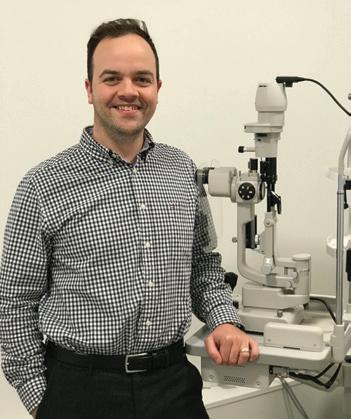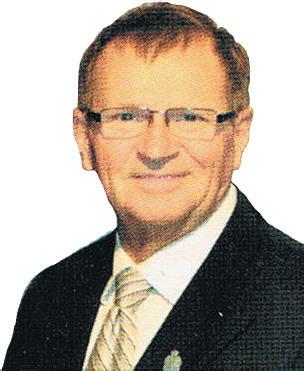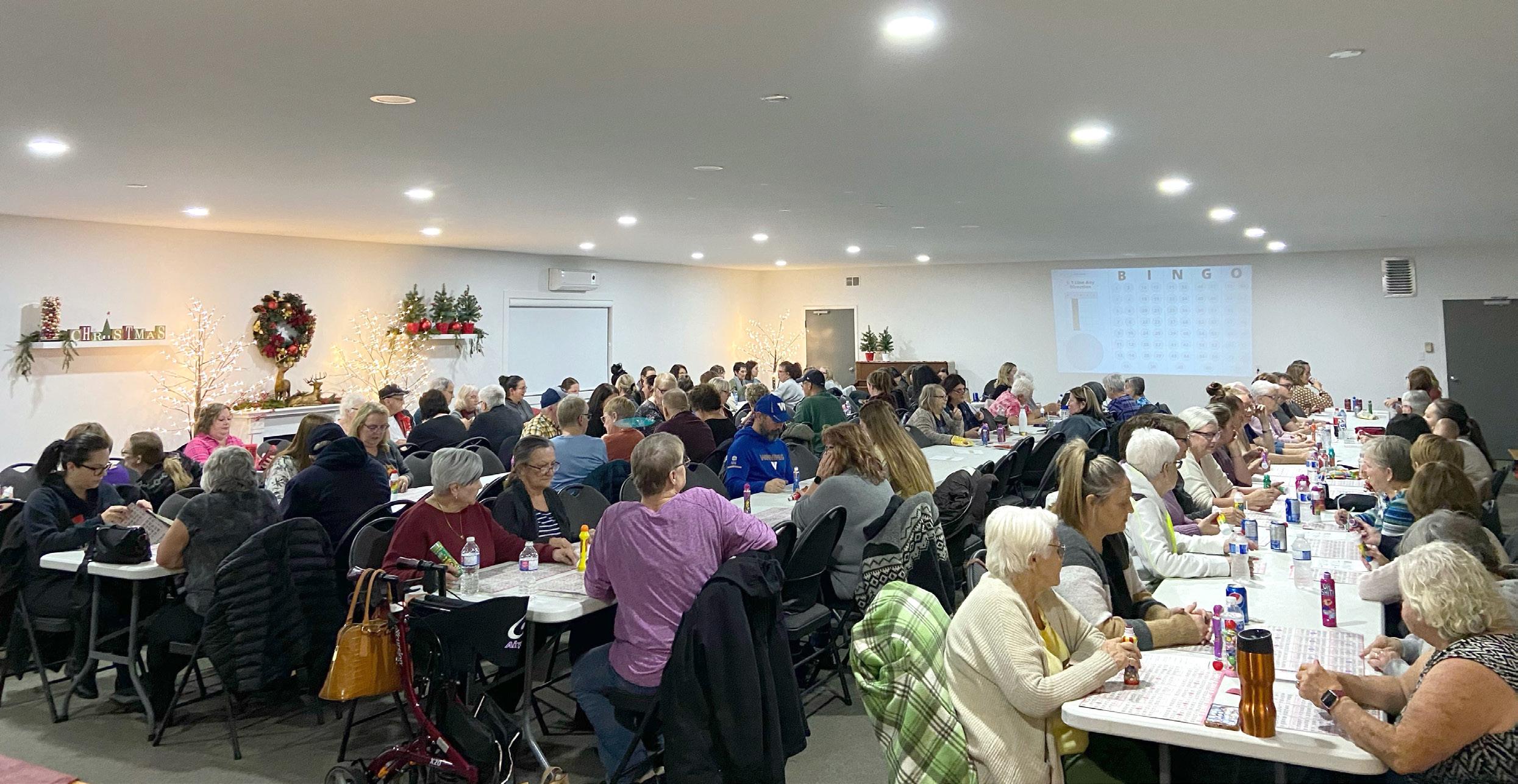

















DECEMBER2022 DISTRIBUTED FREE TO NIVERVILLE, ÎLE-DES-CHÊNES, STE. AGATHE, ST. ADOLPHE, TOUROND, OTTERBURNE, NEW BOTHWELL, AND GLENLEA VOLUME 8 - ISSUE 12 www.nivervillecitizen.com Details on Page 21 Curling Great Jennifer Jones Appears at Gala Prov Pilots Women's Soccer Team Wins Title Details on Page 32 PLEASE TAKE ONE A smarter way to save SCU.MB.CA/SAVINGS • PARKING LOT LINE PAINTING • • PARKING LOT SWEEPING • • SNOW REMOVAL • • PARKING LOT SANDING • • YARD CARE • www.dandmgroundservices.com 204-388-6577 D BRENDA SAWATZKY For many years, parents in Niverville have wondered whether any options for French education, whether immersion or DSFM, will come to town. As the number of interested families grows, the pressure is rising to meet the needs of this segment of the community. LOCAL NEWS Details on Pages 3-7 A French School, S’il Vous Plait? READ MORE ON PAGE 8 Local Fatality a Preventable Tragedy Details
12 Niverville and the RM of Hanover have agreed in principle to a large annexation of land that would double the town’s area. Niverville
Land
LOCAL NEWS The
Providence
made
by
SPORTS & REC One of the most accom-
curlers of all time, Jen-
spoke
LOCAL NEWS
on Page
Proposes
Annexation
women’s soccer team from
College
history
winning their national championship.
plished
nifer Jones,
at this year’s Heritage Centre Gala.












THE CITIZEN | DECEMBER 2022 2 LOCAL NEWS
Adolphe, Ste. Agathe, New Bothwell, Otterburne, and Tourond. Additional copies are manually distributed to businesses in the aforementioned communities, as well as the town of Landmark. The paper is printed in Canada by Derksen Printers Ltd. Republishing of this paper in whole or in part without prior approval is strictly prohibited.
A French School for Niverville, S’il Vous Plait?


 By Brenda Sawatzky LOCAL JOURNALISM INITIATIVE REPORTER m bsawatzky@nivervillecitizen.com
By Brenda Sawatzky LOCAL JOURNALISM INITIATIVE REPORTER m bsawatzky@nivervillecitizen.com
It’s been six years since The Citizen last explored the idea of a French immersion school coming to Niverville, in an article entitled. All these years later, the jury’s still out on whether that will ever be a reality.
But depending on who you ask, there may be some reason for hope.
When the question was posed to the Hanover School Division (HSD) in 2016, just as Niverville sat poised for a new high school, the response was vague but mildly optimistic.
At the time, the division was said to have hired a consultant with experience in implementing new French immersion schools. The findings would help determine the feasibility for HSD.
“We have asked the consultant to review all aspects of creating a French immersion school, to look at all the variables such as enrollment, staffing requirements, space requirements, and grade offerings,” former HSD Superintendent Randy Dueck told The Citizen in 2016.
Three years later, when Niverville High School opened, the curriculum was all in English with the exception of a French elective class.
Unfortunately, when The Citizen requested a copy of the 2016 report, it did not come. Instead, Shelley Amos, HSD’s current superintendent, provided a brief synopsis.
“With so much time passing, the

collected data has limited relevance for any present-day discussion or future planning,” says Amos. “Regardless of the landscape six years ago, the recruitment/retention of French immersion teachers has proven to be increasingly difficult in Manitoba and across Canada. At present, students desiring French immersion are best served by attending schools in neighbouring divisions with such teachers employed.”
And that is, in fact, what local parents have been required to opt for if they want their children to receive a functional education in French that goes beyond the most basic instruction currently available in English schools.
NIVERVILLE STUDENTS ENROLLED IN FRENCH SCHOOLS
Surprisingly, for the 2021/2022 school year, almost 11 percent of Niverville’s 1,218 secondary students are enrolled in other divisions where schools offer an education in French.
Out of the 133 Niverville students learning elsewhere, 57 attend French immersion while the other 76 are enrolled in full-French schools.
HSD is one of the final frontiers among the southeastern Manitoba divisions to not offer any options for French immersion. But even if they did entertain the idea in the future, Amos says they would likely look for a central location in the division to which students would be bussed.
Until then, parents are required to fill out an annual form that requests permission to educate their child outside the division due to “programs not offered locally.”
For Niverville parents who wish to have their children bussed to an immersion school, École Héritage Immersion in St. Pierre-Jolys is the only option. Students of full-French receive bussing transport to École/ Collège Régional Gabrielle-Roy in Île-des-Chênes.
DIFFERENT MODALITIES IN FRENCH EDUCATION
To understand the kind of French learning model that is best for their region, one must first understand the different kinds of French options that are available.
The Canadian Charter of Rights and Freedoms recognizes the right of all Canadians to an education in both of the country’s two official languages.




“The right to minority language education… is designed to enhance our country’s bilingualism and biculturalism and maintain the unique partnership between language groups that sets our country apart among nations,” Section 23 of the Charter states.
Recognizing that English is the dominant language used throughout Manitoba, a governmental initiative began in the early 1970s to incorporate French learning into the public-school curriculum.

THE CITIZEN | DECEMBER 2022 3 LOCAL NEWS WHAT'S INSIDE Managing Editor: Evan Braun Sales Manager: Ray Dowse Operations Manager: Cara Dowse Design/Production Manager: Dustin Krahn Contributors: Evan Braun, Brenda Sawatzky, Jennifer Lavin, Daniel Dacombe, Ty Dilello, Sara Beth Dacombe CONTACTUS Letters to the Editor: editor@nivervillecitizen.com Advertising Sales: sales@nivervillecitizen.com Classifieds/General Information: info@nivervillecitizen.com Artwork/Ad Proofs/Graphics: ads@nivervillecitizen.com Box 266, Niverville, MB R0A 1E0 www.nivervillecitizen.com FREETOSHARE. PLEASERECYCLE. The advertising deadline is 5:00 p.m. on the 20th of each month. The paper will be distributed the first week of every month. Our commitment to the reader is to provide a professional and reliable means of communication that both residents and businesses will value. This newspaper is 100 percent supported by those who choose to advertise within it. Readers who support the businesses who advertise in this publication are also supporting the development and circulation of future issues of this newspaper. Together, we can help build stronger communities. The Niverville Citizen is published monthly and distributed through Canada Post to
those with a postal box in Niverville, Île-
St.
Join today & don’t pay Sale Begins Nov. 14, 2022 Visit, Call or Email for More Details until 2023 FOR DETAILS VISIT ANYTIMEFITNESS.COM 204-961-1919 40 Drovers Run, Niverville facebook.com/anytimefitnessniverville Financé par le gouvernement du Canada Funded by the Government of Canada 1-855-371-5833 | www.redrivergroup.ca Real Estate Appraisals | Property Management | Reserve Fund Studies | Real Property Consulting
all
des-Chênes,
(continued on page 4) D DEPOSITPHOTOS Niverville Choral Society to Hold Second Christmas Concert 35 Committee Introduces Niverville Bingo Nights 34 The Journey of a Lifetime: Kayaking to Hudson Bay 33 Prov Pilots Women’s Soccer Win National Title 32 Niverville Athlete Qualifies for CrossFit Tournament 30 Recovering from Religious Trauma 28 Super Citizens: Kori and Mike Plesiuk, Tireless Community Boosters 27 Province Doles Out Extra-Large Public Library Grants 25 Ukraine War Stories Set Tone for Remembrance Day Service 22 Niverville Heritage Centre Gala Hosts Jennifer Jones 21 Nighthawks Battle Hard through November 18 Nighthawks and Negash Team Up to Create New Coffee Blend 17 Tattoo Artist Seeks to Break Stereotypes 16 Niverville Plans for Final Phase of Business Park 14 Public Transit Opportunities Being Explored for Entire Rural Southeast 13 Niverville Council Proposes Substantial Hanover Land Annexation 12 MCC Events Focuses on Domestic Violence, Healing, and Hope 10 Local Fatality a Preventable Tragedy 8
The most basic form of French instruction is called French Communication and Culture (FCC), which is a required curriculum in all English middle schools.
The Department of Education recommends at least 30 minutes of French instruction daily between Grades Four and Eight. The goal is to provide students with an elemental knowledge of French to aid in simple communication and instill an appreciation for the culture.
In high school, French learning is no longer mandatory but must be offered as an elective course credit.
Early Start French is a curriculum available to schools wishing to provide basic French education from Kindergarten to Grade Three.
The next level is French immersion, a program designed for students whose first language is not French. The aim is for a higher level of mastery in both official languages so students can function equally well in either environment.
Typically speaking, the immersion program begins in Kindergarten and runs through Grade Eight or higher. Teachers in the immersion system are bilingual and use French as the primary language of instruction for the majority of the school day.
In 2021, French immersion was available in 115 public schools crossing 24 different school divisions in Manitoba.
Immersion schools can function on a single-track model, with every student in the school enrolled in French immersion, or the dualtrack model, where the French immersion program and English program co-exist under one roof.
The École Héritage Immersion in St. Pierre-Jolys operates under the single-track model whereas the École St. Adolphe is dual-track.
All immersion schools, whether single- or dual-track, fall under the governance of the school division in which they take up real estate. Should a French immersion school be created in Hanover, HSD would preside over general school policy.
The Bureau de l’Éducation Française is a department within the Manitoba education system whose mandate it is to support French language education. The agency is responsible for French curriculum development, providing instructional materials and library







services, administering government financial assistance programs, and offering educational support services.










In 1994, full-French education options became available to many Manitobans.
The Division Scolaire Franco-Manitobaine (DSFM) is a school division with no territorial borders. Its mandate is to establish and govern schools that offer programming in only the French language.
Enrollment in a DSFM school is limited to children of parents who are deemed “right holders” under the Charter—in other words, at least one parent in the household can identify as a French minority.
A DSFM school operates completely autonomously from the school division in which it takes up real estate.
There are currently 23 fullFrench schools across south and central Manitoba with more than 5,000 students enrolled.
THE CASE FOR A DSFM SCHOOL
Alain Laberge is the general director for DSFM. He lives with his family in Mitchell, within the HSD catchment area. Laberge’s daughter busses to a DSFM school in La Broquerie.
“I always say that the difference between a French school and an immersion school is that in immersion you learn French, and in a French school you learn in French.”
Like all school divisions, the DSFM creates five-year capital plans to determine the most pressing school infrastructure needs.
Need is categorized in a number of ways, including renovation and expansion of existing schools. As well, the plan looks at prime locations for new schools. Each category is then prioritized before the list is presented to the province for consideration.
The DSFM capital plan lists Niverville as a high priority for new school consideration. Locations on their list for new school builds include Sage Creek and Brandon. Both the Sage Creek and Brandon schools have since been approved by the province and await the first dig of the shovel.
A second DSFM school for Îledes-Chênes is on the wish list, followed by a Kindergarten to Grade Eight school for Niverville. Being on the wish list, though, is no guarantee that the province will concur with DSFM’s findings.
HappyHolidays Holidays

“Data shows me that [Niverville] is growing,” says Laberge. “We’re always a little bit ahead of the game. I don’t think we could get a school tomorrow morning because numbers are not yet high enough, but we project that we should get a school in three to four years because it takes 18 months just to build it.”
The numbers Laberge refers to are the percentage of right-holders living within Niverville and the surrounding area who identify as French minority by virtue of heritage or French language fluency.
According to Laberge’s analysis, in spite of its population Steinbach doesn’t have sufficient French right-holders for the province to consider a DSFM school. The Niverville population, on the other hand, is proving to be much more opportune.
“French is not even the third most-spoken language in Steinbach,” says Laberge. “In Niverville, it will be the second-most spoken language. It’s not there yet, but we’re watching the numbers.”
In order to build a case for a new school, DSFM examines a number of factors affecting a region.
First, they look at annual figures coming from the local health authority which show the number of babies in the area born to parents who identify as French or fully bilingual.
Also assessed are the number of students currently leaving the community to attend French school elsewhere and the preschoolers enrolled in French daycares in the region.
Occasionally, DSFM will hold public meetings in communities that are being considered, to determine the level of parental interest.
Once a DSFM school is approved by the province, the division begins working towards the addition of a French daycare in the community.
The goal is to open the daycare at least two or three years prior to the completion of a DSFM build in order to get a jumpstart on future school enrollment. Getting accreditation for a French daycare can take up to 18 months.
According to Amos, another new school in Niverville is not on HSD’s five-year capital plan, although this could change depending on the community’s future rate of growth.
“Niverville Middle School is currently the fullest of the three schools,” Amos says. “Niverville Elementary School and Niverville High School have space. If required
in the future, we would likely see the addition of portables or a school addition at NES or NMS before the province would consider building another new school.”
Laberge recognizes that there’s potential for HSD and DSFM to each make their case for different types of schools for Niverville.
“It could happen that both school divisions want a school,” Laberge says “The Ministry of Education would rather have us and Hanover talking [to each other], and we might say, ‘Maybe it’s a piece of land with two schools on it and we should share the soccer field in the middle.’”
A FRENCH TEACHER SHORTAGE
If there’s one thing everyone seems to agree on, it’s that there is a disparity in the number of French-speaking teachers available in comparison to the demand for them.
Laberge says there’s been a big push for more students to enroll in education at the Université de Saint-Boniface, Winnipeg’s only French-language university.
Canadian Parents for French (CPF) is a nationwide non-profit that has been researching and providing resources to encourage French Second-Language (FSL) learning across Canada for the past 40 years.


Janet Steinthorson is the executive director of the Manitoba CPF branch.
“Years ago we had a [promotion] called French for Life,” Steinthorson says. “That focused on recruitment and retention of FSL students. To some degree, we were a victim of our own success because now we have all these children and we don’t have the teachers to [teach them].”
She adds that the organization has changed its strategy now to encourage more students to pursue degrees in French-language education. They visit secondary and post-secondary schools using campaign strategies that are targeted at students as young as Grade Five.
Altona is one such community that is struggling to find enough teachers for the French immersion half of their dual-track schools.
“Sometimes we’ve had to hire people who are not certified teachers but get limited teaching permits because they have a fluency in the language,” says Krista Curry of the Border Land School Division. “We’ve sometimes had to combine classes if we don’t have enough teachers.”
It’s not a strategy that’s isolated to



Altona, either. The Red River Valley School Division, which oversees École Héritage Immersion in St. Pierre-Jolys, advertises for casual educational assistants (EA) on their website. Applicants are required to fill out a form and provide three references. Nowhere is it indicated that an EA certification is required.
Similar job postings on the DSFM website still indicate that full certifications are required for teaching and EA positions in their schools.




For DSFM, the bigger issue is that of finding substitute teachers. Since almost all French-language teachers have a working knowledge of English too, they have options of subbing in almost any school in Manitoba.
With significant travel miles between many of the DSFM and immersion schools, narrowing your options can mean adding to your daily commute time.
A LOCAL PARENT WEIGHS IN
Lindsay Unrau of Niverville sends three of her four children to St. Pierre-Jolys for French immersion. While she believes in the program, staffing challenges have convinced her that Niverville won’t see a French immersion school anytime soon.
“There just aren’t enough French immersion teachers to go around,” says Unrau. “In some cases, EAs have been put in charge of teaching grades at École Héritage because their teachers have left for better opportunities in the city. It’s actually caused a lot of problems for one of my kids because the EAs were not educated enough to manage learning challenges.”
She adds that some French immersion schools can’t offer as many programming options due to budget challenges. Unrau’s oldest son opted to end his immersion schooling and attend Niverville High School to get more class choices.
“I think a really good story would be, ‘Why isn’t the province better funding French immersion programs, not only to create better opportunity but to encourage and retain more teachers?’” Unrau says.
Herself a student of French-language learning, Unrau says the system needs a major overhaul when the ability to speak a certain language takes precedence over qualifications. Her husband is a paramedic and has seen the same preferential treatment in his profession as well.
THE CITIZEN | DECEMBER 2022 4 LOCAL NEWS Caisse.biz
Support local by opting for the unique quality of the businesses in our communities.
(continued from page 3) (continued on page 7)





























THE CITIZEN | DECEMBER 2022 5 LOCAL NEWS ank you to all our generous partners and all those who donated towards our projects! Your support makes a di erence! Anonymous Donor Aaron & Donna Redekop Taylor McCa rey LLP Niverville Credit Union Southern Comfort Mechanical Paul Cra Financial Inc. JWH Mechanical Ltd. MNP LLP Pratts Wholesale Ltd. Arnold & Orpha Schryvers MCW Consultants Ltd. WM Dyck & Sons Heritage Life Personal Care Home Town of Niverville Heritage Lane Builders Cardinal Health Niverville Bigway Gordon & Vicki Daman Ben & Mika Sawatzky Bill & Roselyn Redekop Tony Kehler & Anita Daman-Kehler Rick & Bonny Friesen OFFICE HOURS: Monday: 9:00 a.m.–5:30 p.m. Tuesday: 9:00 a.m.–5:30 p.m. | Wednesday: 9:00 a.m.–5:30 p.m. Thursday: 10:00 a.m.–6:30 p.m. | Friday: 9:00 a.m.–5:30 p.m. | Saturday: Closed | Sunday: Closed 10 Cedar Dr Unit C2, Niverville, MB 204-540-0250 www.clarityvision.ca DIRECT BILLING WITH MOST MAJOR 3RD PARTY PROVIDERS COMPREHENSIVE EYE HEALTH ASSESSMENTS SURGICAL REFERRALS SPECTACLE DISPENSING CONTACT LENS SERVICE T E D F A L K M P P R O V E N C H E R t e d . f a l k @ p a r l . g c . c a d f a l k . c a 2 0 4 3 2 6 9 8 8 9 t e
329 Bronstone Drive Niverville, MB R0A 1E0

Merry Christmas & C H R I S T M A S B L E S S I N G S

in the New Year
 Ron R. Schuler MLA for
Ron R. Schuler MLA for

1-204-388-4600


feedback@whereyoubelong.ca www.whereyoubelong.ca




This is the time of year where we are busy hunting and buying gifts for those we love. We live for the response a child gives us when they open a gift and the smile, hug, shriek, or happy dance that they give. For we know if they are happy then it makes us feel happy. The great thing about gifts is the joy it brings to both the receiver and giver of that gift.
I want to encourage us in two ways. First of all, to not focus on the amount of the gift but rather the attitude of the heart. Giving something to someone else says I value you. A gift can be something purchased but can also be a smile, an encouraging word, or our time. At a time when so much data comes to us about all that is wrong in our world, or the demands on our wallets and time is high, let us be encouraged to give and in so doing focus on the value of others.
Secondly, I would like to encourage us to value ourselves enough to receive a gift. Life knocks us down from time to time. During these times we tell others we are fine and tend to put up walls and fix things ourselves rather than accepting help and gifts from others. Doing so robs others of the joy of giving and ourselves from the benefit of receiving the gift offered.
While this time of year is more focused on gift giving, let us remember to value one another throughout the whole year and let the positive attitude of the heart be our guide in how we live together as a community.
Mayor Myron Dyck
THE CITIZEN | DECEMBER 2022 6 LOCAL NEWS
SpringfieldRitchot Ron@RonSchuler.com
FULL-FRENCH VS. IMMERSION




For many parents, DSFM will never be an option since it caters to a very distinct community. Even so, they are perfectly happy with the French immersion option.
Natalia Possidônio puts her young son on the bus every day to École Héritage.
“We are a Portuguese-speaking family, and we wanted our son to learn French to improve his Portuguese,” says Possidônio. “Both languages share similar traits. Besides, he can have better work opportunities in the future.”
So far she’s pleased with the Grade One teacher and the regular communication provided to parents. In immersion schools, she says, reports are sent home in English.
The school provides a reading app that parents can use at home to help their children learn to read in French. Possidônio says it gives her the chance to learn along with him.
“My son thinks in English and 70 percent of the time he replies in English to me and my husband.”



























For this mom, it’s not about being fluent in more than one language so much as it is about having working knowledge of a few languages.
Another local mom, Paige Malthouse, says that if a French immersion school came to Niverville, it would be her first
choice.

“One of my first positions was in a call centre,” Malthouse says. “Had I been bilingual, I would have been making more per hour as they paid a premium for French employees.”
She’s confident that many others in the community feel the same way about French immersion. As a matter of fact, she adds, it would give many families just one more great reason to move to the community.
Karis Hutlet speaks French, but her husband does not. The couple has decided that their children will attend DSFM instead of French immersion when they start school.
“The main difference is the level of French from educators and the level of expectation for students,” says Hutlet. “For example, when I was in school, we got punished for speaking English in the hallways and at recess. It is full, full French. Immersion is not as intense and sometimes the quality of French in the staff is subpar.”
Hutlet adds that, from her experience growing up, DSFM students had special access to funding for additional programming such as field trips and extracurricular activities.
“I spoke English at home as a kid because my mom didn’t know French,” Hutlet says. “But my school was so intense that I spoke better French than English. And when I got to university, I had to use a dictionary to learn English words in my textbooks.”
For another Niverville mom, driving her kids to French immersion in Île-desChênes has more to do with daycare options than schools.
Sabrina Broesky knew from the start that she wanted her children to be exposed to French. She started them off as preschoolers in the Growing Minds daycare in Niverville but, according to Broesky, the local daycare quit accepting children who wouldn’t be staying in the Niverville school system.
“Six families actually had to leave and find alternative care in 2017 because of the decision,” says Broesky, whose family was among them.
This conundrum narrowed her options for French schools. She eventually found space for her kids in the Île-des-Chênes daycare, making it more convenient for them to attend the French immersion school there as they grew up.
In 2021, she says, the Îledes-Chênes French immersion school stopped accepting out-of-catchment requests. She was one of the lucky few who got her kids in before that decision was made.
“St. Pierre-Jolys would be ideal,” Broesky says. “They provide bussing to Niverville and the schooling goes from Kindergarten to Grade 12. But it’s childcare that’s the barrier.”

Once her oldest child is in Grade Six, she says, their family will face a whole new dilemma. At that stage, the Îledes-Chênes daycare no longer
provides before- and afterschool care. Transferring him back to the Niverville school may be their only option.
Taylor Chevalier says she’d love the option of French immersion for her kids as they age up, but not if it means sending them out of town.
“The convenience of extracurricular activities close by and still being involved in the town they live in is something I am not able to sacrifice, as much as I would like them to learn French,” Chevalier says. “I would love our whole family to be involved in the same community.”

Indeed, it’s a sentiment shared by many Niverville families who recognize the value of having school friends who also live in your neighbourhood and play on your sports teams.
WHAT CAN PARENTS DO?
According to Laberge, if a fullFrench school is desired, parents should acquire as many signatures as possible on a petition and submit it to the trustees at the DSFM.


On the other hand, if an immersion school is the preference, submitting the petition to HSD trustees is the best option.
Steinthorson of the CPF agrees with the value of submitting a petition. She also recommends that parents form a taskforce and, once the petition is complete, the CPF can help guide the parents from there.
Have a more nuanced opinion? Leave us a comment online.















toWin Enter


Not enoughdoctors and nurses to fill positions. They are struggling. The government should focus on helping our healthcare system but no... they want to increase approved immigrant applications. Our health care won't be able to survive.
This has been building up for many years with the aging population, and more people needing healthcare and not enough tax dollars to support the system which is increasingly unsustainable.
If the government hadn’t cut all the jobs, surgeries and actual care over the health choice, Manitoba wouldn’t be in such dire straits as it is now. It hasn’t been good for decades and they completely destroyed what little was left.
THE CITIZEN | DECEMBER 2022 7 LOCAL NEWS NEW AVAILABLE IMMEDIATELY AVAILABLE IMMEDIATELY SITE FEATURES: • VIDEO SURVEILLANCE • GATED, WELL LIT COMPOUND • 24 HOUR ACCESS • AUTOMATIC CREDIT CARD PAYMENTS • MONTH TO MONTH RENTALS • NEWLY PAVED SITE • EPOXY SEALED FLOORS SELF-STORAGE UNITS 299 Main Street, Niverville, MB | (204) 392-5472 www.nivervillestorage.ca CLIMATE CONTROLLED NON CLIMATE CONTROLLED 12’ x 20’ 8’ x 20’ 5’ x 10’ 10’ x 10’ 10’ x 15’ 10’ x 20’ $279 $209 10’ x 20’ 10’ x 15’ 10’ x 17½’ 5’ x 10’ 7½’’ x 10’ 10’ x 10’ $319 $269 $289 $109 $149 $179 $89 $149 $199 $249 CITIZEN POLL YOUR COMMENTS: Do you agree that Niverville needs a French education option in the coming years? How severe do you feel the growing healthcare crisis in Manitoba has gotten? (1 being the worst and 5 being the best) Congratulations to last month's winner: CURTIS GAMBLE VOTE NOW AT www.nivervillecitizen.com Take part in our monthly poll for your chance to win a $10 gift card for CRU Barber & Co. LAST MONTH'S RESULTS: 49% 13% 12% 13% 13% 1 2 3 4 5
(continued from page 4)
No. Niverville already has sufficient schools for its population, and the surrounding towns will continue to meet the French need.
Yes. The number of parents looking for French learning has increased quickly and will soon reach a tipping point.
Local Fatality a Preventable Tragedy
 By Brenda Sawatzky LOCAL JOURNALISM INITIATIVE REPORTER m bsawatzky@nivervillecitizen.com
By Brenda Sawatzky LOCAL JOURNALISM INITIATIVE REPORTER m bsawatzky@nivervillecitizen.com
Tim Kleinsasser was a 60-year-old father of eight and a member of the Crystal Springs Hutterite colony near Ste. Agathe. To his friends both on and off the colony, Tim had a personality that is best described as larger than life.
On the evening of November 5, Tim’s life came to an abrupt end when his pickup truck plunged into a deep canal.
The fatality occurred at the intersection of Krahn Road and Doerksen Road in the RM of Ritchot. The reason that Tim’s journey along Krahn Road was fatally interrupted is that a bridge was missing, and there was a lack of adequate signage to mark the danger zone.

According to neighbours who farm in the area, the bridge has been missing for about five years now, destroyed with fire by vandals.
For about as long, the missing structure, known as the D20 bridge, has been on the province’s list of infrastructure waiting for replacement.
The Manitoba Transportation and Infrastructure website references the project but offers no date for the bridge’s construction or completion.






“We’ve been lobbying for this since my first year on council,” Ritchot mayor Chris Ewen says. “We’ve communicated with the province asking for this bridge to get rebuilt and we continue to lobby to get that bridge done.”
For years, the only indications that the bridge is missing were checkered dead-end signs erected on the north- and south-facing sides of the canal. One mile south, where Highway 305 turns onto Krahn Road, another sign is attached to the
opposite side of the corner stop sign. It faces Highway 305 and indicates: Bridge Out.
Sometime during the past few months, though, the checkered warning sign on the south-facing side of the canal went missing and no one is quite sure how or why. Only the stump of a signpost was left.
Members of the St. Pierre-Jolys RCMP attended the accident scene along with other emergency personnel on the night of Tim’s untimely passing.
According to the police report, his vehicle made impact while travelling at full speed.
“It appears the male was not aware the road ended, as there were no visible attempts made to stop the vehicle,” the report states.
Tim was declared deceased on the scene.
Ian Kleinsasser is also a member of the Crystal Springs colony, located southwest of the accident scene. He and others from the community visited the site the morning following Tim’s tragic death, looking for clues as to what happened that night.
Based on Ian’s best guess, Tim must have turned onto Krahn Road in error that night, not realizing which road he was about to drive along when he did so.
Ian says Tim travelled north along these gravel roads often and he had known that Krahn was not currently a through road. Normally, Tim would have taken Wallace Road to the west or Loeppky Road to the east of it.
Ian also has a theory about why Tim missed the “bridge out” sign when he first turned onto Krahn Road. Had Tim been travelling eastward on Highway 305, which they suspect he was, his headlights wouldn’t have lit on the warning sign as he made the left turn. Once the turn has been made, there are no further signs along Krahn Road indicating that a bridge is out ahead.
Since that day, the missing deadend sign has been replaced with a new one. Just beneath it hangs a floral arrangement in memory of the husband, father, and friend who died here.
“The fact that the sign was missing in a very dangerous area [is
a problem],” Ian says. “If you drive up to that area, the road slightly rises and it looks like the road actually continues when it doesn’t. You don’t see the ditch, especially at night.”
This intersection, in fact, is only one of a few in the area where a bridge was removed and never replaced. Within a five-mile radius of the accident site, at least three more such intersections exist.
One of them is located exactly two miles west on Levesque Road. All of these intersections are marked by similar dead-end signs but no barricades.
Only one of these other bridges is listed on the province’s infrastructure website for replacement.

Just over a week after Tim’s accident, people are still trying to reconcile the senseless nature of his passing.
“People are just absolutely devastated,” Ian says. “Tim had his fingers in so many things in the community.”
Tim was, in fact, instrumental in managing the HR division of a large industrial company located on the colony.
He regularly interviewed and hired workers from outside the community, giving him a broad base of friends and acquaintances from surrounding communities and other colonies. For this reason, the sadness of his loss reverberates far beyond the colony’s borders.
To Ian, Tim represented a man of integrity and love in action.
“If Tim saw that someone was struggling and needed help, he’d be the first one there to help,” Ian recalls.
“He had an incredibly big heart.”
An outpouring of support for Tim’s family has come in from all around the province, Ian adds. Many have reached out to share heart-warming stories of Tim’s impact on their lives—stories of a man who was generous, humble, and selfless.
“His sons have mentioned that that’s an aspect of their father’s legacy that they want to keep alive,” Ian says. “To take up the responsibility of seeing when somebody needs a friend and to be that friend.”
But members of the community hope that the province will finally act so that no one else will meet Tim’s fate at these intersections without bridges. A sign is not enough, Ian says. If not a bridge, then a wellmarked barricade is in order.
The Citizen reached out to Manitoba Transportation and Infrastructure for a response. To date, none has been forthcoming.
“We’ve heard people say that somebody should be punished for this, but I think the family and most of the community are saying, ‘We’re not going to let this anger us. We’ll rather choose to be forgiving,’” says Ian. “People make mistakes and it’s so unfortunate that somebody lost their life, but are we going to make it any better if we seek vengeance? I think the answer is a resounding ‘No.’”

THE CITIZEN | DECEMBER 2022 8 LOCAL NEWS • Real Estate Transactions • Corporate Law • Agriculture Law • Wills • Estates • Succession Planning • Civil Litigation www.snj.ca Unit B - 62 Main Street, Niverville Tel. 204-388-9300 | Fax: 204-388-9350 Box 458 Niverville, MB. ROA 1EO PHONE: 1-204-388-4509 FAX: 1-204-388-6283 EMAIL: nandatrucking@hotmail.com REPAIRS & PARTS ON ALL MAKES & MODELS HEAVY TRUCK, TRAILER & EQUIPMENT SALES
The site of an accident in the RM of Ritchot where a local motorist lost his life.
D BRENDA SAWATZKY


















































THE CITIZEN | DECEMBER 2022 9 LOCAL NEWS EMAIL: chamber@niverville.com PHONE: 204-388-6140 President: Amanda Wiens | Vice-President: Elvin Krahn | Executive Director: Kylie Matechuk Executive Director Assistant : Bre-Ann Boulet | Treasurer: Nicholas Bergmann Executive Member: Karen Albaugh | Members: Bryan Trottier, Ben Dueck, Scott Wallace, CHAMBER news www.niverville.com Welcome to New Chamber Members ORGANIC BODY SUGARING PRICKLY PEAR PRICKLY PEAR 204.782.8610 pricklypearsugaring@gmail.com pricklypearbodysugaring Unit C5, 10 Cedar Drive, Niverville Building stronger leaders and healthier teams DARRELL KEHLER Leadership Coach & Consultant www.scopeleadership.com As business owners ourselves, it’s exciting to see the growth and passion within our thriving business community. There is space for us all to provide the unique services, products and experiences for Niverville and the surrounding communities. If you have a business idea and want to invest in Niverville, now is the perfect time. Please contact us if you need direction or a supportive ear. We want to extend our gratitude to our membership for their continued investment in the Niverville Chamber of Commerce and are excited to come together more in the new year. We will continue to promote, support and be the voice of our business community. Merry Christmas and Happy Holidays to you and your loved ones this season! Ajax Roo ng Anderson Window Cleaning Brazen Beauty Bristal Hauling Clarity Vision DeLuxe Electric Inc. Earth + Hide Forgotten Flavours Parallel Motions Massage therapy Salina Marie Photography Savage’s Plumbing and Renovations Ltd. Shanda O enberger Independent Norwex Consultant Thom Brokerage and Consulting Inc. Urban Flavours Whitetail Meadow Your Mortgage Couple - Mortgage Architects Delaquis Antiques Delaquis Antiques FURNITURE 204-388-4850 pgdelaquis@gmail.com • SALES • • REFINISHING • • REPAIRS • 1-431-588-2702 2 - 18 3rd Ave S, P.O. Box 165 Niverville, Manitoba R0A 1E0 info@camslawoffice.com www.camslawoffice.com AREAS OF PRACTICE CIVIL LITIGATION REAL ESTATE LAW FAMILY LAW IMMIGRATION LAW DISPUTE RESOLUTION WILLS AND ESTATE got stuff? We Reward Referrals! 204-392-5472 299 Main Street, Niverville nivervilleindoorstorage@gmail.com BRYAN TROTTIER 204.371.8842 trotco@mts.net A VENTURA Development
Legislation Sets Higher Accessibility Standards




 By Brenda Sawatzky LOCAL JOURNALISM INITIATIVE REPORTER m bsawatzky@nivervillecitizen.com
By Brenda Sawatzky LOCAL JOURNALISM INITIATIVE REPORTER m bsawatzky@nivervillecitizen.com
Beginning January 1, 2023, a new set of codes will come into effect to help improve life for those with accessibility challenges.
The Accessibility for Manitobans Act (AMA) was first enacted ten years ago. The goal of the legislation was to work at removing barriers that make accessibility difficult in both indoor and outdoor public spaces for those experiencing all levels of mobility challenges or sight impairment.
“To develop accessibility standards, the Manitoba government is working with representatives from the disability community, as well as the public and private sectors,” says the AMA website.
At a November 16 meeting, Niverville council voted to update the municipal code.
This means that new sidewalks need to have tactile pads where the sidewalk ends to act as a warning for the visually impaired.
These are brightly coloured pads for those who have nominal vision and are heavily textured so a walking cane can easily pick up the change in surface.
As well, sidewalk slopes will be regulated to ensure that inclines and declines don’t create difficulty for wheelchair users.
CAO Eric King says the legislation will affect only new construction. Existing public buildings and exterior infrastructure will fall under the new codes when they undergo repair or replacement in the future.
The Town of Niverville has been actively installing the tactile pads for a number of years. They can be found along most of Main Street and on the sidewalks in and around the CRRC and Niverville High School.
MCC Events Focuses on Domestic Violence, Healing, and Hope
By Brenda Sawatzky LOCAL JOURNALISM INITIATIVE REPORTER m bsawatzky@nivervillecitizen.com
On November 7, Mennonite Central Committee (MCC) Manitoba held the first in a three-part series focused on bringing awareness and attention to the growing problem of domestic violence and abuse.

In conjunction with Domestic Violence Awareness Month, the first session, held at the Pat Porter Active Living Centre in Steinbach, took an in-depth look at intimate partner abuse, the many myths attached to the subject, and the means for providing effective support for victims.
Public session two took place on November 21 at 7:00 p.m. There, the presenter identified the affects of witnessing or experiencing abuse as a child and how it impacts people developmentally.
The series will conclude with a full-day workshop specially curated for faith leaders, pastors, counsellors, and those in spiritual care roles. This session will help create awareness of the fact that the church community is far from exempt from the issue of abuse. Those in church leadership roles will gain tools for recognizing signs of abuse, assisting victims to safety, and holding perpetrators accountable.
The two presenters are Val Hiebert and Jaymie Friesen, both coordinators for MCC’s Abuse Response and Prevention program.
Hiebert holds a PhD in sociology and anthropology and currently teaches at the University of Manitoba. Friesen is working towards her master’s degree in psychotherapy and has gained many years of practical experience working in sexual assault crisis centres prior to MCC.
The MCC abuse program began more than 20 years ago and was originally known as Voices for Non-Violence.
“MCC does a lot of peace work
and most of that work for many years has been really focused overseas in developing countries,” Friesen says. “Part of this program was a mandate to do some work more locally, recognizing that violence and harm happens within faith communities and in homes as well.”
Throughout most of the year, Friesen and Hiebert’s MCC work is relatively church-centric, hosting conversations in faith-based settings in order to help break the silence and stigma that surrounds partner abuse.
While they are not direct service providers, the duo can make referrals to the many resource centres available to victims of abuse. As well, they partner with victim support groups and are working on developing programming to help perpetrators change their violent patterns.
Until now, Friesen says, abuse was a topic rarely discussed in the


church due to the shame attached to it. The church can unwittingly perpetrate a climate which is ripe for abuse.
“Wherever you see a strong patriarchal culture, you also see higher rates of violence,” Friesen says. “Not to say that the culture causes abuse, but I think wherever you see that power imbalance established in a teaching, it often lends itself to women feeling like they have to obey their husbands and they don’t have a right to speak up.”
It’s up to spiritual leaders to speak out against abuse, she adds, instead of responding in a way that makes victims feel like they need to forgive and let it go.
Intimate partner abuse is not limited to physical violence. It can take a number of other forms— including sexual, emotional, or psychological abuse—and might include manipulation, stalking, and harassment.
Whatever the method, relationship abuse boils down to one partner gaining and maintaining power and control over another.
“Intimate partner abuse is essentially about denying someone a choice,” says Friesen. “It’s not allowing someone to have a voice. It’s about denying someone their dignity. It’s about violating boundaries and taking away autonomy and safety. These are the things that are at the core of what is abuse.”
According to Statistics Canada, Manitoba has one of the highest reported rates of violence against girls and women. The provincial rates for intimate partner abuse are also near the top, trumped only by Saskatchewan.
The most frequent calls received by the Winnipeg police are related to domestic violence. This amounts to approximately 44 calls a day, or 16,000 calls per year.
These calls come from every
THE CITIZEN | DECEMBER 2022 10 LOCAL NEWS Katie Knebel 204-392-3030 HOME MARKET EVALUATION IN BRIEF CHRISTOPHER HOFER CALL ME TODAY FOR A FREE MARKET EVALUATION! 204-807-5701 chrishoferrealtor@gmail.com www.christopherhofer.ca
Val Hiebert and Jaymie Friesen, coordinators for MCC’s Abuse Response and Prevention program. D BRENDA SAWATZKY
neighbourhood and people from every walk of life and are not distinctive based on socioeconomic status.
Perhaps most compelling of all, the rates of violence against girls and women is 1.8 times higher in rural Manitoba compared to Winnipeg.

Statistically, only one in five cases of abuse are reported to the police, suggesting that actual rates of abuse are much grimmer than they appear.
Friesen also confronts a number of common myths held by victims and also those outside of the situation.
One, she says, is the belief that abuse hasn’t occurred unless physical violence is involved. In reality, many partners suffer more intensely under psychological or emotional abuse since it results in no external bruises to offer as evidence.

“Sometimes these [victims] wished that they’d just get physically hurt, because then it would make it real and concrete,” says Friesen. “[Psychological abuse] is so incredibly damaging, and yet at the very essence of it, it causes you to doubt the experience.”
Another myth involves the idea that abuse only happens in opposite-gender relationships.
Results from a 2018 study indicate the contrary is true. Fifty-four percent of sexual minority men experience psychological, physical, or sexual abuse compared to 36 percent of heterosexual men.



















For sexual minority women, the numbers rise to 67 percent, versus 44 percent of heterosexual women.
The unfortunate reality, Friesen says, is that few resources and shelters are available to men at all, regardless of their sexual orientation.
Another commonly held belief, especially in faith communities, is that sexual abuse cannot happen within a marital relationship.
“When I do my work counselling women, I make the assumption that if there’s abuse, there’s also sexual abuse,” says Friesen. “Sadly, they usually come to a recognition that what happened in their sexual life was not consensual and that they believed it was their duty to do the things that they were being asked to do.”

Finally, misunderstandings also circulate suggesting that the victim brings the abuse upon themselves by not establishing clear boundaries with their partner.
According to Friesen, victims themselves often believe they are guilty of this.
The reality, though, is that exercising a right to boundaries can actually exacerbate the violent behaviour, since at its core abuse is about power and control.
For those on the outside who are looking to support an abuse victim, it’s important to recognize the difference between unhealthy relational conflict and coercive, controlling abuse.
The former may happen during occasional bursts of anger which result in demeaning words or mild levels of physical aggression. Here, couples therapy can be very affective.
Conversely, couples therapy is usually counterproductive when one partner is being controlled by the other, as it limits their ability to share honestly and puts them at greater risk of abuse following the session.
So what can a person do to support a victim of intimate partner abuse? Friesen

































says that the first thing is to validate them by believing their story. This can become a pivotal moment for the victim, buoying them with the courage they need to at last pursue help.
Next, be prepared to connect them with available resources and accompany them to the police or resource centres at their request.
Never act on the victim’s behalf without their permission, Friesen stresses. This has the potential to make the situation worse.

Finally, everyone can make a difference by normalizing conversations around abuse, giving victims the freedom to speak on their own behalf.
In terms of perpetrator rehabilitation, there are support programs such as Caring Dads that have proven effective, but they are not the right setting for pathological abusers.
“With coercive controlling violence, those people often fall somewhere on the narcissism spectrum,” Friesen says. “Those individuals are often not willing to take responsibility and they don’t see that they’ve caused harm. They’ll somehow spin it so that they are the victims.”





Similar to addiction, without recognition of a problem and a deep, committed desire to change, change is unlikely. Support people who attempt to work with narcissists can likewise be seduced by their manipulation tactics, Friesen warns, so professional help is best suited here.
FOR MORE INFORMATION







To learn more about MCC’s Abuse Response and Prevention programs and resources, visit https:// abuseresponseandprevention.ca



THE CITIZEN | DECEMBER 2022 11 LOCAL NEWS ARE YOU IN THE StaceyHeide@royallepage.ca 204.914.2522 www.StaceyHeide.com I'm your local real esttate expert! All real estate services provided by Royce Finley Personal Real Estate Corporation CALL STACEY HEIDE TODAY FOR ALL YOUR REAL ESTATE NEEDS! Not intended to solicit properties already listed. CUSTOM METAL FABRICATION www.fusionindustries.ca NOW HIRING FOR DAY SHIFT: Fitters Welders Maintenance Personnel Yard Helper SEND RESUME TO: Kevin@fusionindustries.ca 204-388-6631 ext 107 OR DROP OFF AT: 41095 6th Ave. N., Niverville, www.nivervilleautobody.ca COLLISION REPAIR AUTO GLASS REPAIR & REPLACEMENT Ferd Klassen Phone: 204.388.4657 Fax: 204.388.4394 Email: info@nivervilleautobody.ca
Ambassador Canadian Reformed Church
By Brenda Sawatzky LOCAL JOURNALISM INITIATIVE REPORTER m bsawatzky@nivervillecitizen.com





On November 21, Niverville’s town council released pertinent information regarding a proposal that, if approved, will significantly increase the community’s land holdings, helping to pave the way for future expansion.

“Generally speaking, Niverville intends to grow to the east along Highway 311 and towards Highway 59, away from the Red River,” the press release states. “The annexation proposal affects roughly 50 parcels, consisting of nearly 2,600 acres of land.”







The parcels in question currently lie within the boundary of the RM of Hanover and border both sides of Highway 311.

While there is a smattering of homesteads along the route, the bulk of the land is primarily agricultural in use.
With Hanover’s support, a proposal has been submitted to the Manitoba Municipal Board for a transfer of the land to the Town of Niverville.
The goal for this land is to provide space for growth in all sectors, including commercial, industrial, institutional, and residential.
In anticipation of this continued growth, council hired a team of community planning consultants at Urban Systems to perform a sustainable growth strategy some six months ago.

The resulting report projects that within 15 to 20 years, Niverville will have developed all of its currently available residential land.


“Although 20 years may seem like a long time, it is important to plan proactively for the future to ensure sustainable growth for Niverville,” states the press release. “Transferring lands now will







ensure that [the parcels] do not become fragmented or developed with incompatible uses, and more difficult to transfer or develop in the future.”









Another advantage of acting now is that it allows the town to begin applying for both provincial and federal grants available for water and wastewater infrastructure.


This would go a long way towards moving Niverville into position as a regional hub in the southeast.
“Once completed, new projects and regional partnership opportunities will become possible for Niverville and for our neighbours,” the release states.

Should the transfer be approved by the province, council says they’ll ensure that the land continues to be used in the same way it is now, respecting the rural nature of the area.

As well, the landowners transitioning into Niverville’s tax base will be given special consideration at tax time to avoid undue financial hardship.

“I would like to thank the Reeve of Hanover, Jim Funk, and his council for their willingness to work together on this annexation with us,” Mayor Myron Dyck of Niverville told The Citizen . “As our region looks at the potential for future growth, this is good for both of our municipalities in terms of sustainability.”




Over the coming weeks, members of town council, along with representatives from Urban System, will set up meetings with the affected landowners and community stakeholders.
Public open houses will follow for anyone interested in the full layout of the plans. The Citizen will report new details as soon as we learn them.
12 LOCAL NEWS Ambassador
Join us
for
Refreshments
Sunday,December18 ContactPastorJamesatjames.victor.zekveld@gmail.com INVITES YOU TO:
Church is hosting a Hymn-Sing
at 7pm
an evening of song at 116 3rd Ave. S. Niverville.
to follow.
Suppliers and installers of complete insulation packages performance-insulation.ca 204-408-3310 • Attic Blow in • Spray foam • BIBS – High Performance Insulation System • Wall insulation FREE ESTIMATES Follow us on Directors: Melanie Ducharme Danielle Auld info@prairiesouldancecompany.ca 204-392-5624 10 Cedar Drive, Niverville EMAIL US FOR MORE INFORMATION! REGISTER TODAY! 204-388-5366 Plumbing • Heating • Air Conditioning
In green, the amount of land that is proposed to be annexed by Niverville from the RM of Hanover. D URBAN SYSTEMS
Public Transit Opportunities Being Explored for Entire Rural Southeast
By Brenda Sawatzky LOCAL JOURNALISM INITIATIVE REPORTER m bsawatzky@nivervillecitizen.com
Igniting connections is the theme of a new initiative recently created which will explore the feasibility of a public transit system that services the entire rural southeast.
The initiative began this fall as a collaboration between the RM of Piney and Eco-West Canada, a not-for-profit Winnipeg-based organization whose mandate is to promote sustainable economic development in rural communities through green economy infrastructure.
“Public transportation isn’t only for people living in cities,” says Melanie Parent, coordinator for the Piney Community Resource Council. “It’s a service deserving of all Manitobans, both rural and urban. Improving public transit is about giving residents of southeast Manitoba the freedom of equal access to social, health, and economic opportunities that enhance our quality of life.”
To launch the new program, the partners invited leaders from 17 municipalities and First Nation communities to participate in a round table session in Steinbach on September 22. The RM of Ritchot was among the 13 municipalities and communities represented at the meeting.
The Southeast Regional Transportation Initiative (SRTI) arose from this meeting and is led by the key originating partners, along with stakeholders and experts including TONS (Transportation Options Network for Seniors), the University of Manitoba, as well as a collection of municipal and First Nation leaders and local businesses.
“We believe quite strongly that transit and mobility are fundamental to the development of resilient and sustainable rural communities,” says Dany Robidoux, executive director of Eco-West. “However, we also
understand how the barriers of place-based differences are a major challenge to overcome for rural communities wanting to transition to greener modes of transportation.”
Moving forward, the next step for the SRTI will include visits by project organizers to a variety of communities in the region east of the Red River and south of the TransCanada Highway.
Their goal will be to gain a more complete understanding
social isolation,” Gamble says. “It allows seniors to age in their own communities rather than having to move to obtain services not available in their community and especially being able to attend medical appointments.”
This is particularly true in more distant municipalities such as Piney whose proximity to any major urban centre makes regular driving prohibitive.
But the need is not limited to seniors, Gamble adds. Regional
For many rural communities, public transit could also go a long way to promoting tourism to their heritage sites.
But creating a public transit system goes beyond connectivity and access, Gamble says. It holds enormous potential for a greener future for all.
According to Gamble, transportation is responsible for Manitoba’s largest output of carbon pollution, since more than 90 percent of vehicles in the province rely on fossil fuels.
“Rural and northern households have greater obstacles to reducing transportation emissions than urban households due to longer travel distances that are part of daily life and less flexibility to shift to lower carbon transportation,” Gamble says. “Policy approaches need to account for these items.”
In terms of pulling off such a widespread initiative, Gamble says that there’s strength in numbers.
And since the region is comprised of so many smaller pocket communities that face the same transport challenges, she believes that working collaboratively as a whole may provide some affordable solutions.
IN BRIEF
School Divisions Receive Funding for New Programs
By Brenda Sawatzky
Parient | Piney Community Resource Council






of the people who make up the region, what their travel needs are, and what barriers currently stand in the way of them getting where they need to go.
Connie Gamble is the lead regional data collector for SRTI. She looks forward to fine-tuning the region’s transportation findings once all the research has been compiled.
Still, there are some certainties her organization already possesses.
“Transportation is needed by seniors and others to address
transit systems could make rural communities more attractive to immigrants. It would provide more work commuting options to everyone and create a reduced reliance on fossil fuels and the need for a vehicle for every driver in a household.
It would provide more family support by creating affordable connectivity between urban and rural family members. Young people would have the option of living at home while attending university or working outside of their community.
“The RM of Piney has worked on a number of projects successfully with other partners, which brings more ideas, more attention, a stronger business case and more funding to [the table],” Gamble says.
The RM of Piney first began researching public transport options for their own residents in 2020.
Some time later, the CAO of Piney discovered that Eco-West was working on the same initiative, only on a broader scale. At this stage, they partnered for a stronger outcome.
Residents can watch their local news sources, RM websites, and social media sites for community outreach launches coming to their area soon.
LOCAL
JOURNALISM
INITIATIVE REPORTER m bsawatzky@nivervillecitizen.com
In October, the province announced new investments for students from Kindergarten to Grade Twelve. Under a project called the Teachers Idea Fund, $3.2 million has been approved for 162 projects in 29 divisions.
“This funding provides teachers, staff, and school leaders with the resources to develop innovative projects that support high quality learning and positive outcomes,” reads a press release.
Both the Hanover School Division (HSD) and Seine River School Divisions (SRSD) will be beneficiaries of this year’s funding.
During the 2022–2023 school year, middle and high school students within the HSD will participate in career development and life exploration programs in their classrooms and at a variety of workshops.
HSD received just over $54,000, which will cover the costs of honorariums, licensing, substitute teachers, cameras, and transportation. The division also received $70,450 to pilot a second program they call Inclusive Extracurricular Activities to Build Peer Connections.
The programs will target students from across the division in Grades Five to Twelve.
Themes have been developed for each block that will mimic extracurricular activities that are typical to school life.
For the SRSD, $60,250 is being allocated to their middle years project called Dialectical Behaviour Therapy (DBT) Skills Group.
They’ve already been successfully running the program as a credited course available to their high school students.
TimeWise® Miracle Set 3D
TimeWise® Miracle Set 3D™

It’s your skin against the world!
It’s your skin against the world!
Everyday life is stressing your skin out. Fight back against premature skin aging with a three-dimensional skin care approach.
Everyday life is stressing your skin out. Fight back against premature skin aging with a three-dimensional skin care approach.
Contact me to experience the powerful results for yourself!
Contact me to experience the powerful results for yourself!
Joyce Harnett
Independent Sales Director www.marykay.ca/jharnett 204.228.3620
Name‡ Independent Beauty Consultant‡
Mary Kay Personal Web Site Address‡ Phone Number‡
Name‡ Independent Beauty Consultant‡




Mary Kay Personal Web Site Address‡ Phone Number‡

THE CITIZEN | DECEMBER 2022 13 LOCAL NEWS Let's connect about your property needs 204-230-6762
Award-winning service built around client satisfaction
“Public transportation isn’t only for people living in cities. It’s a service deserving of all Manitobans, both rural and urban. Improving public transit is about giving residents of southeast Manitoba the freedom of equal access to social, health, and economic opportunities that enhance our quality of life.”
Melanie
Niverville Plans for Final Phase of Business Park





 By Brenda Sawatzky LOCAL JOURNALISM INITIATIVE REPORTER m bsawatzky@nivervillecitizen.com
By Brenda Sawatzky LOCAL JOURNALISM INITIATIVE REPORTER m bsawatzky@nivervillecitizen.com



Niverville’s newly appointed council got right to work at their first public meeting held on November 1. The agenda included a public hearing for a business park subdivision, which if passed would allow council to begin development of streets and 55 new lots in the fourth and final phase of the Niverville Business Park.
Phase four will be developed based on demand and will provide for a number of three-acre lots, making it possible for council to extend their promotional campaign to a broader market.





Conversely, if demand continues for smaller lots, the three-acre lots can be subdivided to fill that need as well.
Large industry, too, could






be accommodated if buyers choose to purchase a series of adjoining lots in one block of the park.



This is already the case with Fusion Industries, which owns a combination of four adjoining lots making up a total of ten acres.





















“We’re not really saying no to anything at this point,” says CAO Eric King. “[This provides] a little bit more certainty and long-term vision.”
Town water and sewer services will continue to be optional for each new purchase, but so far King says all of the existing business owners in the park have opted to put in their own private septic tanks and wells.
The cost for a business to bring town services to their property, King adds, comes to somewhere between $30,000 and $40,000.
“At this point, there’s one or two people that have asked for [town services],” he says. “But as soon as they find out the cost to bring it there, they say, ‘No, we’re good.’”

According to King, all lots in the first three phases are currently spoken for. The addition of phase four will bring the total number of lots in the park to about 105.
Having reached the final phase to be developed, King says council’s conversations will eventually need to focus on whether the town will consider the acquisition of more land or to rely on landowners around the community to rezone their land for this purpose.
“I don’t think [council] needs to make that decision this year or next year, but they’re definitely in that thought process when they





talk about it at planning sessions,” adds King.
Council voted unanimously in favour of subdividing the lots for phase four of the business park.
NEW DEPUTY MAYOR

Another order of business was to announce the reassignment of the deputy mayor position from previous council member John Funk to Chris Wiebe.
Mayor Myron Dyck also welcomed his new council to the chamber table and congratulated them on their recent election wins.

“It’s always appreciated when people are willing to serve their community in this capacity,” Dyck told council.
“I’m looking forward to working together as a team to make the community better going forward.”





THE CITIZEN | DECEMBER 2022 14 LOCAL NEWS www.sparkline.ca 20 Cedar Drive, Ni ille, MB 204-388-4888 www.sparkline.ca 20 CEDAR DRIVE, NIVERVILLE, MB Alignments- Brakes-Tire-Safeties Diagnostics-Free Shuttle and Courtesy Car George Dyck & Son 311 highway | Box 433 Niverville Manitoba R0A 1E0 204-388 4870 geodyck@hotmail.com Some Things are Best Left to the Professionals! Quality & reliable service. Over 10,000 windshields installed. ACCREDITED George Dyck PHONE: EMAIL: St. Pierre: 204-433-7956 Vita: 204-425-3264 www.graydonvet.com Drs Venessa Graydon, Anne Whipple & Julia Domke PROUDLY SERVING THE AREA FOR THE LAST 12 YEARS FULL SERVICE GROCERY, LIQUOR & BEER VENDOR 259 MAIN STREET, NIVERVILLE NIGHTHAWK LAGER NOW AVAILABLE 2 - 18 3rd Ave S, P.O. Box 165 Niverville, Manitoba R0A 1E0 AREAS OF PRACTICE info@camslawoffice.com www.camslawoffice.com 1-431-588-2702 CIVIL LITIGATION REAL ESTATE LAW FAMILY LAW IMMIGRATION LAW DISPUTE RESOLUTION WILLS AND ESTATE
www.nivervillecitizen.com New stories published daily!
Back: Councillors Meghan Beasant, Nathan Dueck, and Bill Fast. Front: Mayor Myron Dick and Deputy Mayor Chris Wiebe. D BRENDA SAWATZKY

THE CITIZEN | DECEMBER 2022 15 LOCAL NEWS
Tattoo Artist Seeks to Break Stereotypes
By Jennifer Lavin m jlavin@nivervillecitizen.com





Pokes on You is one of Niverville’s newest businesses, and owner Brianna Marchand is ready to share her passion for body art with the community she loves so much.


Marchand’s family moved to Niverville when she was ten, and back then she wasn’t thrilled about it. But now, at 23, she doesn’t want to live anywhere else. So she’s settled down with her dogs, Emma and Willow, and her cat Stevie.


Marchand has always been a creative person and has been producing art in one form or another since she was a child. Her dream was to earn her living as an artist, but she believed it was an unrealistic goal.
During the pandemic, though, Marchand ordered herself a tattoo machine thinking she could tattoo herself and her friends for fun.
But then, she says, she accidentally fell in love with it.
“For over a year, all things tattoo consumed my mind
and my time,” Marchand says.
She pursued all the learning she could about the tattoo industry, received her certificate in body modification, and completed a seminar in bloodborne pathogens, infection prevention, and control.
“Slowly,” she says, “I gained confidence in myself and my skill and developed a deep passion for tattooing.”
Marchand says she grew up believing that only a certain type of person had tattoos.
“I associated tattoos with only the most hardcore people, hypersexualized pinup girls, and dark and intimidating art.”
That belief may have been true in the past, but Marchand wants to make sure she is helping to break those old stereotypes.
“For both tattoo artists and people who get tattooed I think there’s been a stereotype, this mould to fit into,” she says. “So essentially my goal for this studio is to bend that mould a little bit, to create a space where tattooing becomes more than just ink
to skin. I want Pokes on You to be a place where every client feels safe to speak their mind and take their time.
I believe that every client should feel valued whether they are getting their tattoo as a form of self-expression, remembrance, healing, confidence, or just simply because they want to have art on their body.”
Marchand’s goal for her shop, located at 18 Third Avenue South in Niverville, is all about inclusivity.
“My hope is that people of all shapes, colours, sizes, and sexual orientations feel safe to be exactly who they are in my space. I am so deeply honoured by everyone who has supported me so far and I hope that I can contribute to a memorable, meaningful, and positive experience for everyone who comes in the future.”

FOR MORE INFORMATION
Marchand and her art can be seen on Instagram: @pokesonyou_.

THE CITIZEN | DECEMBER 2022 16 LOCAL NEWS 204-901-0013 Stay safe this holiday season with ride options from Niverville Taxi & Niverville Party Bus CALL OR TEXT:
Brianna Marchand has opened a new tattoo studio in Niverville.
D JANELLE LAGASSE
Nighthawks and Negash Team Up to Create New Coffee Blend
By Sara Beth Dacombe m sdacombe@nivervillecitizen.com




















The Niverville Nighthawks and Negash Coffee are pleased to announce a partnership to produce a brand-new Nighthawks coffee blend.
A portion of the proceeds of all sales of the branded coffee will go back to the town’s new MJHL team. The team will use the funds to contribute toward operating costs as well as any upcoming infrastructure needs, such as the east bleacher system and eventually a new permanent dressing room for the team.










The team is structured as a nonprofit organization, backed by a community membership group of more than 50 businesses and individuals. Negash Coffee is one of the team’s founding members, so it was a natural decision for the Nighthawks to partner with them to create a branded coffee.
“Negash is a business that has really become an incredible Niverville success story,” says Nighthawks vice-president Ray Dowse. “Henok Gebre and his team built the business and brand from scratch, investing a significant amount of time, work, and money along the way. His heart for people and the community really comes through in all that he does, and it’s amazing to see how the community has really embraced him and his business. Negash has become one of the local companies that has really helped put Niverville on the map.”
Dowse says the Nighthawks organization also aims to






















contribute to the identity of Niverville. The collaboration between the team and Negash creates an opportunity to bring greater visibility to the larger community.

























The two businesses may have come to the decision mutually, but Dowse says that all decisions about the coffee blend itself came from the experts at Negash, owners Henok Gebre and Adam Hashi.
“It was a two-way merge,” said Gebre. “We decided to see if they were interested in doing a branded coffee, and so we asked them and they were planning to ask us at the same time. It was a true combined idea. So we made a blend, but we can’t really say what it is because the way we created it is really a different type of bean and a different type of roast. We made two types, a medium and a dark, so this covers all the bases. We didn’t think about just one person or one group, but about how we can cover the tastes from A to Z. That way, anybody can enjoy what we’ve created.”
The attention to detail that comes through in the coffee’s taste profile showcases the degree to which the family puts their heart into the business.
“This is what we love to do,” says Hashi. “There’s really not any other coffee the way we do it. We take what we do very seriously, in the traditional way. If you think about how your grandma does things in the kitchen, that’s the way we do it. We take the time to create the exact flavour we are looking for, the flavour people will really enjoy.”
For Negash, the feeling of family extends beyond the kitchen and into the community itself. Though
they have only been in business locally for a few years, Gebre and Hashi have gained a reputation for going above and beyond when partnering with other local organizations and showing support for community endeavours.
“There’s nothing else like Niverville,” Hashi says. “We started our family here. Some of us live here in town. It’s a beautiful town. There’s no way to describe it really. It means so much to us as a family. Niverville people are beautiful people, very kind. We’ve grown up with this town and we are always going to be here to support other people in this town. Life is a two-way street and other people have helped us. What we get, we will also give to help them. It’s a family. It is a team.”
Hashi adds that they’ve been thinking for a long time about how to create a product that gives back to the town and has the name Niverville attributed to a specific blend of coffee.

The partnership may have come about naturally, but Dowse confesses that he started out in life with a natural dislike for coffee. He admits that it took until he was in his 40s when Negash opened before he started to come around.
Ever since, he has been drinking their coffee.








“I wanted to support Negash when they opened up their new business, so I would come by for tea,” says Dowse. “One day I had ordered a London Fog, and Henok told me it was a London Smog. When asking what that was, he said it’s a standard London Fog with a shot of espresso in it. At first I thought it was odd. But after a
few weeks of drinking the London Smog, I eventually ditched the tea and have been a coffee drinker ever since!”
So Dowse is now a true fan of coffee, but are the owners of Negash truly hockey fans?
“That is a trick question for Africans,” says Gebre. “We grew up playing soccer. Even at this moment, we are in the World Cup for soccer. But no doubt, we enjoy watching any type of sports. When it comes to sport, we play it, like basketball, volleyball. The only thing we didn’t play growing up was hockey. But it is certainly an exciting sport. And we like to watch.”
Hashi says that hockey is really fun and unique… but it’s certainly something he and his family didn’t grow up with back home in Ethiopia.
“But when we came to Canada, we noticed it is the number one sport in Canada,” says Hashi. “You become who surrounds you, so since we are living in Canada we decided to adopt it. It’s a very special sport to immigrants and we love watching it. We love seeing people enjoying it and we can feel like we’re part of the community crowd, which is the backbone of the society of sports in Canada.”
Nighthawks coffee will be available to be purchased through the Negash Coffee website and store, at all Nighthawk home games, as well as at the Niverville Bigway. Cost of a standard 500-gram bag of Organic Ethiopian Grade 1 Coffee will be $19.99. There will also be a 1000-gram bag available for $39.99.






THE CITIZEN | NOVEMBER 2022 17 NIVERVILLE NIGHTHAWKS UPCOMING HOME GAMES DEC. 2 @ 7:30 P.M. 7:30 VS. WAYWAYSEECAPPO WOLVERINES DEC. 31 @ 6:00 P.M. VS. WINNIPEG FREEZE DEC. 9 @ 7:30 P.M. VS. STEINBACH PISTONS STANDINGS WEST DIVISION TEAM GP OTL SOL W L PTS 1 2 3 4 5 6 EAST DIVISION TEAM GP OTL SOL W L PTS 1 2 3 4 5 7 6 MJHL GOALIE LEADERS TEAM GOALIE GP GA SV% GAA 1 5 9 13 17 3 7 11 15 19 2 6 10 14 18 4 8 12 16 20 MJHL POINTS LEADERS TEAM GOALIE GP G A PTS 1 5 9 13 17 3 7 11 15 19 2 6 10 14 18 4 8 12 16 20 ** AS OF NOVEMBER 1** Aidan Comeau WNK 11 18 0.937 1.79 Dominik Wasik STN 12 23 0.935 1.92 Ethan Farrow OCN 10 21 0.933 2.13 Cole Plowman STN 12 27 0.913 2.23 Mason Lobreau NEE 15 33 0.929 2.31 Malachi Klassen WNK 18 41 0.918 2.46 Tresor Wotton WAY 14 36 0.918 2.55 Loic Mainguy-Crepault SVS 7 19 0.923 2.64 Bailey Monteith POR 12 31 0.898 2.70 Kobe Grant SVS 19 53 0.929 2.78 Cole Sheffield DAU 14 38 0.906 2.83 Jayden Catellier POR 13 36 0.899 2.84 Marko Belak DAU 8 23 0.908 2.86 Chase Hamm OCN 19 55 0.908 2.86 Ethan Kadatz NIV 10 29 0.908 3.01 Owen LaRocque VIR 12 38
Chris Fines NIV 12 41
Hunter Tarves SEL
Eric Reid VIR 15
Peyton Trzaska
Davis Fry STN 24 12 27 39 Riley Zimmerman 20B 29 16 19 35 Lucas Brennan SEL 20 20 13 33 Travis Hensrud STN 21 17 15 32 Ty Paisley STN 24 10 22 32 Ashton Paul OCN 29 13 16 29 Justin Keck
24 12 16 28 Alex Bernauer OCN 22 10 18 28 Hayden Lacquette POR 24 7 21 28 Jakob Jones SVS 26 13 14 27 Andrew Boucher WAY 23 7 20 27 Luke Janus WPB 25 13 13 26 Mike Svenson WNK 27 16 9 25 Josh Paulhus NIV 22 11 14 25 Austin Peters POR 21 10 15 25 Ian Amsbaugh STN 24 6 19 25 Carson Baptiste WAY 18 11 13 24 Tyson Smith SEL 23 4 20 24 Brandon McCartney POR 24 3 21 24 Trent Sambrook WNK 27 3 20 23 28 0 2 16 10 34 OCN BLIZZARD 26 1 1 15 9 32 SWAN VALLEY STAMPEDERS 26 2 0 14 10 30 DAUPHIN KINGS 23 3 2 12 6 29 WAYWAYSEECAPPO WOLVERINES 27 4 0 11 12 26 VIRDEN CAPITALS 25 0 0 12 13 24 NEEPAWA TITANS 24 0 0 20 4 40 STEINBACH PISTONS 26 4 1 16 5 37 WINKLER FLYERS 23 0 0 18 5 36 PORTAGE TERRIERS 23 0 1 12 10 25 NIVERVILLE NIGHTHAWKS 25 2 1 7 15 17 WINNIPEG BLUES 24 3 1 6 14 16 SELKIRK STEELERS 22 2 0 2 18 6 WINNIPEG FREEZE
0.878 3.34
0.898 3.71
11 36 0.897 3.76
54 0.873 3.90
NEE 7 22 0.871 4.09
SVS
The Citizen extends an apology to Scott Stroh for omitting a credit for his photo on page 12 in the November 2022 print edition.
Henok Gebre, Ray Dowse, and Adam Hashi with the new Nighthawks-branded coffee.
D SARA BETH DACOMBE
Nighthawks Battle Hard through November
 By Ty Dilello m tdilello@nivervillecitizen.com
By Ty Dilello m tdilello@nivervillecitizen.com
In November, the Nighthawks battled hard to strengthen their hold on fourth place in the MJHL’s East Division. As of this writing, they’re up eight points over the fifth-place Winnipeg Blues.

Overall, this was a high-intensity month of hockey, kicked off by the team’s first extended road trip.
The month also featured a fourgame winning streak and a celebrated victory against a local powerhouse team: the Steinbach Pistons.


NOVEMBER 4 (SWAN VALLEY, AWAY)
The Nighthawks kicked off their road trip to the western side of the province with a 4–3 loss against the Swan Valley Stampeders. The team still came away with a single point, since the loss came in the shootout.

“It’s nice to hit the bus with the guys and go on the road,” said Nighthawks head coach Kelvin Cech. “That’s part of the fun of junior hockey, and the travel is so good in our league that it’s pretty short. We got no complaints.”
The game was one the Nighthawks probably should have won, but they


















let it slip it away. Niverville led 3–1, but Swan Valley climbed back into the game with a pair of goals to force overtime.

Goals on the night for Niverville were scored by Brendan Bottem, Braden Panzer, and Josh Paulhus.

“I thought the team played very well and battled very hard for me tonight,” said netminder Chris Fines, who was playing his first game back with the team since being injured six weeks earlier. “They kept lots of shots to the outside and made my night pretty easy. It’s too bad I wasn’t able to make one more save in the shootout
to keep it going. But that’s hockey. And we will get them next time.”
Fines had been out of action with a torn MCL in his left knee, but he was terrific in goal, making 38 saves on 41 shots.
“Fines was great in his first game back,” said Cech. “He had one monster save in the first period which let him know that he’s fine and back, so he settled in after that and was rock solid for us.”
The Nighthawks also had a pair of new players making their MJHL debut on Friday night in Lucas Bourdon and Bryce Warkentine.
Warkentine hails from Landmark.


“Lucas on the backend was very composed. He moves the puck well and really calms things down for us,” Cech said. “Bryce is kind of the opposite, as he makes a beautiful mess of things and is a hard forechecker. Both of them haven’t played a lot of hockey, so it was great to get them in the lineup for the first time.”
NOVEMBER 5 (OCN BLIZZARD, AWAY)































































The Nighthawks ventured to The Pas on Saturday evening to face off against the MJHL’s West Division-leading

THE CITIZEN | NOVEMBER 2022 18 NIVERVILLE NIGHTHAWKS
The Nighthawks in action against the OCN Blizzard. D SCOTT STROH UPCOMING HOME GAMES DEC. 2 @ 7:30 P.M. VS. WAYWAYSEECAPPO WOLVERINES DEC. 31 @ 6:00 P.M. VS. WINNIPEG FREEZE DEC. 9 @ 7:30 P.M. VS. STEINBACH PISTONS
OCN Blizzard.


























Niverville was simply outmatched, despite Ethan Kadatz stopping 32 of 35 shots in goal for the Nighthawks.
“It was a positive experience for our guys that haven’t played in that arena, as there’s a ton of history and character in that building,” said Cech. “We would have enjoyed it more if we picked up two points, but that’s the way it goes sometimes.”
“It was a good experience for the team, as it was our first long trip. So it really gave us the opportunity to bond more as a team,” added forward Carter Spirig. “It was a different type of atmosphere, and the boys adapted and saw the game from a different perspective this weekend.”
The Nighthawks opened the scoring just three minutes into the game when Spirig potted home his fifth goal of the year, assisted by Bortis and Brendan Bottem.
“It all started with a hard forecheck, forcing them to turn over the puck, and then Bortis found me in the high slot,” said Spirig. “I knew being in a high-scoring spot that I had to get the puck off my stick quick, and then I beat the goalie high-glove for the goal.”
Unfortunately for Niverville, from there the Blizzard would score a single goal in each period to win the game 3–1.


“We had trouble handling their forecheck, as they got our defencemen turning, and they were on us really quick,” said Cech. “We had trouble getting back to pucks and moving efficiently. They’ve got a real identity, and they work hard, so they were hard to play against tonight.”
NOVEMBER 8








(SELKIRK STEELERS, AWAY)

The Nighthawks lost their third in a row after falling on the road to the Selkirk Steelers 5–2.
After a scoreless first period, Selkirk scored twice in the early stages of the second. To the Nighthawks’ credit, they fought back later in the period as Bortis scored back-to-back to tie the game at 2–2.
Selkirk was the better team in the third period as they pulled away with three consecutive goals, including two empty-netters.
Fines stopped 31 shots on the evening in goal for the Nighthawks.
“We battled to get back into the game in the second, but Selkirk found another gear in the third period,” said Cech. “But things like that can happen in this league when everything is so close and competitive.”
Although Selkirk is ranked lower in the standings than Niverville, it’s a testament to the parity in the MJHL that anyone can beat anyone on any given night.
Cech warned that you can’t take any teams for granted.
“You’re fortunate to beat anyone in this league,” he said. “Sometimes it’s dangerous to look at teams below you in the standings, so you always have to
respect your opponents. It’s a learning curve for our guys, and everything is a new experience. So at the end of the day, Selkirk is happy tonight, and we’re not.”
NOVEMBER 9




(STEINBACH PISTONS, HOME)
The Nighthawks earned perhaps their biggest win of the season on Wednesday night at home when they knocked off the league-leading Steinbach Pistons by a 6–4 score.
“Steinbach is such a great team and is in first place for a reason as they went to Game 7 of the league finals last year,” said Cech. “To halt them for one night feels awesome, and the boys are fired up for this win.”
Steinbach opened the scoring midway through the first period, but Ty Kennett replied right away for the Nighthawks.
Steinbach got another goal a few minutes later, but once again the Nighthawks replied with Carson Reed scoring his third of the season.

The Pistons took their third lead of the game, scoring early in the second period, but after that it was all Nighthawks on offence.
Niverville scored three times in the second period with goals from Warkentine, Paulhus, and Panzer to lead 5–3.
Niverville played strong and shut down Steinbach’s offence in the third period. Both teams scored a other goal, and the game ended 6–4 in Niverville’s favour.
“The first two times we played Steinbach, they outshot us badly,” said Cech. “We defended well, but we didn’t have the puck at all. We have had a lot of new faces on our team since then, though, so this game is definitely a measuring stick of where we’re at. We were also on a three-game losing streak coming into this, so to snap that against the top team in the league, we’re pretty happy tonight.”
Fines was excellent in the Nighthawks’ goal, stopping 35 shots on the evening to get his first win at home this season.
“He never falters,” said Cech. “He’s a rock for us back there, and we’re so happy to get him this year on our team.”
One of the nice stories on the night was Warkentine scoring his first Nighthawks goal of the season. Tonight’s win was sweeter for him because Warkentine had played for Steinbach last season.
“We just played hard, and we’re hard on pucks all night, and just didn’t let up,” said Warkentine. “After not getting invited to Steinbach’s training camp this season and Coach Kelvin taking a chance on me, it sure feels sweet.”
NOVEMBER 11

(WINNIPEG BLUES, HOME)










The fans at the CRRC were in for an offensive treat on Friday night as the hometown Nighthawks outscored the Winnipeg Blues 7–5 to win their second straight game.
Niverville found their offence right away, scoring two goals in the game’s opening three minutes. Winnipeg got one back at the end of the first period to cut the deficit to 2–1.
The two teams traded goals early in the second period, before the Nighthawks reasserted their lead with another goal in the dying moments of the second period.
The play really opened in the third, and the Nighthawks’ fourth line was able to capitalize and poke home some loose pucks. Niverville led 7–3 late in the period, and although the Blues were able to score twice in the final few minutes, there would be no fairy-tale comeback for them.
Kennett led the way on the night
puck in the net.
“Our top line has done such a good job all year carrying the mail, and tonight the pucks weren’t going in for them,” Cech said. “And our power play struggled too. So to get Ty Kennett, Warkentine, and Boles scoring. It was enormous for us.”
NOVEMBER 18 (SELKIRK STEELERS, HOME)
The Nighthawks captured their third straight game when they defeated the Steelers 4–3. It wasn’t perhaps the team’s best game, but they found a way to win on home ice.
After a scoreless first period, Niverville trailed twice in the second but equalized each time thanks to goals from Desmond Johnson and Bottem.
In the third period, the Nighthawks scored a pair of goals in under a minute from Bortis and Brendan Kerr to give them a 4–2 lead.
Although Selkirk got one back in the dying moments of the game, the Nighthawks held on for the victory.
Fines stopped 27 of 30 shots in net to pick up the win for Niverville.
“Right from the drop of the puck, our defence controlled our zone with and without the puck so much better than last night’s game,” said Cech. “They were crisp, made good reads, and their habits were awesome. Our forwards used their skill from there, and we were able to find the back of the net a bunch.”
“We are very consistent in our play, and we’ve been playing a full 60 minutes lately, which is key,” said captain Brett Tataryn. “I love our game tonight because we had the pressure on all game.”
NOVEMBER 25 (PORTAGE TERRIERS, AWAY)
The Nighthawks had their four-game win streak snapped when they fell 6–2 to the Portage Terriers on the road at Stride Place. With the loss, the Nighthawks remain in fourth place in the MJHL’s East Division with a 12–10–1 record.
with two goals for the Nighthawks, while other goals were scored by Bottem, Hayden Wheddon, Spirig, Merik Boles, and Warkentine.
“We got pucks out of our zone when we needed to and on the opposing net, and things happened,” said Kennett. “It felt good to produce for the team and help us get a win.”
Fines made 26 saves on 31 shots in goal for the win.
“That’s junior A hockey, that no lead is ever safe, as we were up 7–3 and held on to win 7–5,” said Cech. “It was a bit of a buzzkill, but we came out in the third period and defended each other and defended our goalie. We’re really tired of seeing our goalie bumped into, so I was proud of the guys for how they responded to that.”
One of the team’s unsung heroes is defenceman Ethan Kelly, who doesn’t get on the scoresheet much but is an excellent shutdown defenceman and stuck up for his team by fighting an opposing forward.
“We’re a resilient team, and Ethan is a huge part of that,” added Cech. “He assisted on Ty [Kennett]’s first goal tonight. He plays tough, and that’s part of the game to drop the mitts. He’s a heck of a defender.”
Cech was especially happy for his team’s depth scoring, as all four forward lines are capable of putting the

“I think we played like we had a week off, as it was pretty sloppy out there by us,” said Cech. “It wasn’t the right amount of urgency on our part, and we had a tough time handling their forecheck. Fortunately, we had some big performances from Evan Bortis and Chris Fines. We kind of rallied around that, and we were able to get the two points, which is all that really matters.”
Fines was excellent once again in goal for the Nighthawks. The Stonewall product stopped 36 of 39.
“Chris is a huge part of our team, and we really believe in him,” Cech added. “He’s playing fantastic, and we’re lucky he’s on our side.”
NOVEMBER 19 (SELKIRK STEELERS, AWAY)

For the first time in franchise history, the Niverville Nighthawks have won four games in a row after dismantling the Selkirk Steelers 7–3 on Saturday night at the Selkirk Recreation Complex.
With the win, the Nighthawks improve their record to 12–9–1.
It was a game that the Nighthawks controlled from start to finish and one they led on the scoreboard the whole way through.
“It was definitely a good response,” said Cech. “We didn’t want to critique a win, but we thought the standard we showed last night wasn’t up to par. Everyone was better from top to bottom tonight.”
Warkentine led the way for the Nighthawks with a hat trick. Other goals for the club were scored by Bottem, Paulhus, Bortis, and Luke Schaeffer.
Portage proved why they are one of the top teams in the MJHL this season, as they carried the play for much of the game. The Terriers scored twice early in the first period before Panzer got one back for Niverville.
In the second period, the two teams split goals, as Isaac Rentmeester scored for the Nighthawks, making the game 3–2 Portage after 40 minutes.
The Terriers pulled away in the third period with three tallies to give them the 6–2 win.
“It was pretty back and forth for the first two periods,” said Cech. “Early on, they capitalized on a couple of tough bounces where they scored twice from behind our net, which happens once a year usually, and it happened twice in one game. We defended well through 40 minutes and thought we gave ourselves a chance, but in the end they pulled away.”
Fines was excellent in the Nighthawks’ goal as he stopped 33 shots on the evening.
“They possessed the puck a lot more than we did, and our forecheck wasn’t quite fast enough to retrieve the puck,” Cech said. “Usually when that happens you’re not getting as much offensive zone time. It probably could have been worse if Fines didn’t play as well as he did in the net.”
The Nighthawks are back in action on Wednesday, November 30 at the CRRC when they take on the Winnipeg Freeze in a highly contested divisional matchup. The puck drops at 7:30 p.m.
“At this time of year, lots of teams are going through injuries and illnesses and whatnot,” said Cech. “So we just want to take care of our bodies and minds, and that starts with our yoga session tomorrow. And then just getting back on the ice on Monday and preparing for our next game with the Freeze.”
THE CITIZEN | NOVEMBER 2022 19 NIVERVILLE NIGHTHAWKS www.mjhlnighthawks.ca PURCHASE YOUR GAME DAY TICKETS AT
“It’s nice to hit the bus with the guys and go on the road. That’s part of the fun of junior hockey... We got no complaints.”
Kelvin Cech | Head Coach













































































































































































































































































































































THE CITIZEN | NOVEMBER 2022 20 NIVERVILLE NIGHTHAWKS UPCOMING HOME GAMES DEC. 2 @ 7:30 P.M. VS. WAYWAYSEECAPPO WOLVERINES DEC. 31 @ 6:00 P.M. VS. WINNIPEG FREEZE DEC. 9 @ 7:30 P.M. VS. STEINBACH PISTONS Make it a Nighthawk Christmas www.mjhlnighthawks.ca TOQUES | PUCKS | MAGNETS | STICKERS | LANYARDS | MINI STICKS | BEER KOOZIES | MITTENS | WATER BOTTLES | T-SHIRTS | HOODIES $129.99 $20 - $35 $19.99 $39.99 DARK & MEDIUM ROAST COFFEE HATS & TOQUES FAN JERSEYS - ADULT & YOUTH WHITE AND NAVY BEER KOOZIES MINI STICKS PUCKS 500 g 1 kg $6.50 $8.50 $6.50 Shop at our December home games (Dec. 2 & 9) from 6:30pm until a er the 2nd intermission. No ticket required. at our Pop-up Shop - Wed, Dec. 14 from 5-9pm in the lobby of the CRRC. OR
Niverville Heritage Centre Gala Hosts Jennifer Jones
By Brenda Sawatzky LOCAL JOURNALISM INITIATIVE REPORTER m bsawatzky@nivervillecitizen.com
More than 200 people attended the 2022 Niverville Heritage Centre Gala on November 5 to hear this year’s keynote speaker, Jennifer Jones, one of the most decorated and recognizable women in the history of curling.

After two years of COVID-related cancellations, the gala returned to wow its guests with a lavishly decorated hall and fourcourse steak dinner. The cost of the entire event was generously taken care of by anonymous donors, channelling all proceeds of the night toward the organizers’ almost $60,000 fundraising goal.
This year’s Heritage Centre projects include a variety of upgrades and improvements to the NCU Manor and the Heritage Life Personal Care Home, making life just a little bit better for its many aging residents.
Mayor Myron Dyck opened the ceremony with an introduction of Jones and her accomplishments, most notably her gold medal win at the 2014 Olympic Games where she became the first female skip in history to go through the tournament undefeated.
Jones is also a two-time Women’s Worlds champion, a six-time Canadian champion, and nine-time provincial champion.
“Sports is not the only place where there is stress and where success has been accomplished,” Dyck told the crowd. “Wes Hildebrand, the CAO of Niverville Heritage Centre, has seen his share of challenges in the past couple of years with running seniors housing and a health centre during a pandemic. Together with his staff, he has kept things moving forward with a calm countenance while piloting the Heritage Centre ship through winds from unknown directions and unknown speeds.”
When Jones took the podium, she marvelled at the Heritage Centre’s aging-in-place facility and its ingenuity.
To the surprise of many, Jones shared her own ties to the community. Niverville was home to Jones’s mother, her grandparents, and a collection of aunts and uncles. Jones’s great-grandparents lay buried at the Heritage Cemetery on Main Street.
For the balance of the night, Jones took the audience back in time through her infamous curling career, beginning in 2005 at the Scotties Tournament of Hearts when Team Jones won its first Canadian championship.
It was here that Jones gained
notoriety for a shot that many commentators to this day regard as the greatest championship shot in the history of the game.
In 2006, Team Jones entered the Olympic trials. Their dream was cut short when Jones developed kidney stone pain and the team underperformed.
In the following four years, they collectively rose to the top of the podium almost everywhere they competed, eventually ranking number one in the world.
The 2010 Olympic trials soon followed, but once again the team played below their expectations.
“We went to the trials and… every one of you here could have beat us,” Jones mused. “We were really bad. And it was in that moment that we really had to sit down and reflect. We had all these accomplishments, but when it came to the one that really [mattered], we didn’t bring out the best in each other.”
Jones described the following months as among the hardest she’s ever had to face as team leader. Knowing that a change in team members was necessary for their future success, it fell to her to shake the team up.
In the end, she says, it was the best decision she could have made.
“Change is how we embrace the greatest challenges in life,” said Jones.
New member Kaitlyn Lawes joined the team at a very young age and with little credibility apart from raw talent.
“Everyone thought we were a little bit crazy, because Kaitlyn wasn’t proven,” Jones said. “But what we did know is that she had the energy and excitement to learn and to evolve and to try new things. She was going to bring back our love of curling.”
Their first major curling event as a new team took place in Oslo, Norway in 2010. Jones says it was
traditional for the team to tour portions of Europe prior to their big games. This time, they found themselves in Turkey, getting to know each other in the steamy milieu of a Turkish bath.
Inside the changing area, the ladies were each provided with miniscule towels to cover themselves. The scantily clad Kaitlyn led the way into the bath area.
“I’m hiding behind Jill, because she’s really tall,” Jones joked, Jill being a reference to none other than Jill Officer, Jones’s long-time second. “A lady grabbed Kaitlyn’s towel and ripped it off her. And I just said, ‘Welcome to the team!’ And we all laughed and laughed. It was in this moment that we found our team [because] we were vulnerable and willing to put ourselves out there in an uncomfortable situation.”
The team did in fact find their stride from that day forward, continuing to excel on the national and international circuits in the lead up to the 2014 Olympic trials.
But misfortune visited again, this time in the way of a massive knee injury sustained by Jones while watching her husband play at the World Championships in Switzerland. The fall left her with two pulled ligaments and damaged cartilage, requiring surgery.
Jones’s prognosis presented little hope of a full recovery before the Olympic trials. She was crestfallen. She’d let her team down.
To complicate matters further, Jones also discovered that she was pregnant with her first child. She was given two options: prolong the surgery until after the birth and abandon her Olympic dream or proceed with the surgery without the use of general anaesthesia.
She opted to undergo surgery. Through morning sickness, Jones pushed through physiotherapy, working hard to get back on track for the Olympic trials.
“My team believed in me,” she
said. “But I knew that if I never made a comeback, my team would know that I gave it my all and that is the power of a true team. By believing in me, they took away the stress of trying to make it up to them.”
Two and a half months later, and very pregnant, Jones was back on the ice.
A year later, Team Jones competed in the Olympic trials hosted in Winnipeg, just as her daughter Isabel turned 11 months old.
“The pressure could not possibly have been [greater]. We’re in Winnipeg at the MTS Centre and everybody was expecting great things from us—and we went and played better than we’ve ever played.”
In 2014, the team was bound for the Olympics in Sochi, Russia.
“It was a dream of a lifetime, but we made it that way,” she said. “We showed up at those Games with the biggest positive attitude I’ve ever seen of anybody… We went in with the attitude that nothing was going to stop us, and nothing did.”
The team went on to set performance records for curling that had never been seen before.
On the last shot of the final game, Jones describes as an adrenaline rush like she’s never experienced either before or since.
“I knew that if I missed that shot and I had to go and talk to the media afterward, [my teammates] would have been by my side. They would have told the media, ‘There’s nobody else we would rather have throw that last shot.’ And that’s why we made it.”
Their successes continued and they later went on to qualify for the 2022 Olympics in Beijing, China.
Jones closed her address by bringing the message back home. Just like Team Jones, it’s taken years of hard work and teamwork to make the Niverville Heritage Centre the success it is today.
“I look at this facility and how this town took responsibility,” she said. “To build this is remarkable to me. This should be in The Globe and Mail and The National Post You took responsibility for your future by doing this and I’m so honoured to be a part of it.”
By the end of the event, organizers of the fundraising gala not only saw their $60,000 goal met but exceeded it by almost $6,000.
Hildebrand says he continues to be moved by the town’s ongoing generosity towards the seniors in the community. The gala was the icing on the cake which followed the spring reopening of much of the seniors programming that had been put on hold during the years of pandemic.
Jesus is King, yet the Jesus in the gospels doesn’t always look like a king. God, in his mysterious ways, delights to work through weakness to demonstrate his strength.
e gospel of Luke provides the most startling contrasts. While the newborn king can barely nd room in the inn, thousands of angels welcome the king before certain shepherds out in the countryside. Most eyes see a rather unremarkable birth to an unremarkable couple. But God opens the eyes of certain shepherds. In the gospel of Matthew, we have a similar story. God allows wise men of the East (probably Persians) to discern the king’s birth, while the wise religious leaders in Jerusalem fail to see this king.
Our situation today re ects the situation at Jesus’ birth. Our Lord Jesus went up into heaven and is seated at the right hand of his Father. He is coming again to judge the living and the dead. rough the eyes of faith, however, we can see our ascended Lord, described in Revelation 1 with hair white as wool, eyes like re, feet like bronze, and a voice like the roar of many waters. We do not see him with physical eyes at the right hand of God, but we continue to see him through the proclamation of the good news that he is the king who saves us from our sins.
What do you see? rough the Spirit of Christ in the power of the gospel, you, too, can have the eyes of faith.


THE CITIZEN | DECEMBER 2022 21 LOCAL NEWS
www.ambassador-canrc.org
Pastor James Zekveld pastor.ambassador@gmail.com 204-905-4297
Ambassador Canadian Reformed Church
eHiddenKing
Jennifer Jones speaks at the Heritage Centre Gala. D BRENDA SAWATZKY
Ritchot Council Looks at Crime Rates, Speeding
By Brenda Sawatzky LOCAL JOURNALISM INITIATIVE REPORTER m bsawatzky@nivervillecitizen.com
Staff Sargent Guy Landreville made an ap pearance in the RM of Ritchot’s council chambers on November 1 to provide an overview of crime stats over the last quarter.
Compared to the previous quarter, traffic-related charges and warnings were down. Crimes against property and persons were also down.
Landreville reported on headway being made within local policing that should help improve their visibility in the Ritchot region.
Three new members have been added to the local detachment, he says. The new members are still in training, but he says it’s a big step in the right direction.
Councillors Jason Bodnarchuk and Janine Boulanger were quick to suggest two locations in their wards that are particularly prone to heavy-footed drivers.
Red River Drive in Howden, Boulanger says, is building a reputation as a speedway.
For Bodnarchuk, speeding on Main Street in St. Adolphe poses exceptional concern when children are boarding and disembarking school buses.
Landreville noted their concerns and indicated a willingness to deploy patrols to these areas more frequently.
Seeking further solutions, Mayor Chris Ewen inquired about the feasibility of bring ing photo radar to rural areas in the future.
Landreville says he’s not aware of any locations outside Winnipeg where these systems are in use. There’s a lengthy process to getting that done, he says, which includes creating bylaws.
When asked whether the staff sargent anticipated an RCMP detachment in Ritch ot’s future, Landreville had an answer.
“Not here,” Landreville replied. “We have [the] Niverville location that’s going to open on a municipal contract on April 1.”
According to Landreville, the Niver ville satellite office will be located in that community’s town office and will provide workspace for three constables, a corporal, and a staff sergeant.
Ukraine War Stories Set Tone for Remembrance Day Service
By Brenda Sawatzky LOCAL JOURNALISM INITIATIVE REPORTER m bsawatzky@nivervillecitizen.com

Hundreds gathered at the Niv erville Heritage Centre on Nov ember 11 to spend a moment in thoughtful reflection over the rav ages of wars past and present, and to commemorate the men and women who’ve served and con tinue to serve.
“This event brings people together in a spirit of learning and fellowship,” Remembrance Day committee member Donald Stott told those gathered. “It’s through intergenerational conversations that the torch is passed on so the memory of those who made the ultimate sacrifice will continue and that the values that they fought for will live on in all of us.”
This year marks the eightieth anniversary of the Dieppe Raid, where almost 5,000 Canadian sol diers came ashore on the heavily defended French coast alongside British and American allies. It was known as Operation Jubilee.
The strategy led to important lessons learned, which would eventually influence the success of D-Day two years later, but not without sacrifice. More than 900 Canadians lost their lives on those shores and thousands of others left wounded or were taken as prisoners of war.
Special guests at this year’s event included the Leushko family, who represent the thou sands of other families currently caught up in the modern-day war in Ukraine.
Introduced by speaker Roger Armbruster, the family of ten suc cessfully fled their wartorn home land and arrived in Manitoba as immigrants in March of this year.
“I find it significant that some 148 years ago, back in the year 1874, evacuees from the area that is the present-day Ukraine came to this region in order to find a safe place,” Armbruster said. “Today, in the year 2022, we once again have evacuees from a war zone in Ukraine coming to [Canada].”
Two of the Leushko children performed a song for the audience in their native language, described as a prayer of mercy for those still suffering the ravages of war back home.

Through the use of an inter preter, father Leushko followed, providing attendees with an inside
look into life in the midst of war.
Life for the Leushkos was similar to that of most Canadians before the war broke out in Feb ruary. The children all attended school and the eldest daughter was happily enrolled in her first year of university. Mr. Leushko held down a number of jobs to provide for his family.
On February 23, the day before the war started, Leushko’s son turned 16 years of age.
He was never able to celebrate his special day.
“Many cities in the Ukraine, including ours, became targets and were hit by various missiles,” said Leushko. “Many people suf fered. There were a lot of casual ties and buildings were destroyed. These people had to evacuate.”
News came to the Leushko household from relatives living in Russian-occupied cities. They told of people being robbed or forced from their homes by Russian soldiers.
Leushko heard from a friend who’d barely managed to escape with his family.
“He dressed up his daughters in very ugly clothing and put mud all over their faces,” Leushko said. “That way, if the Russian soldiers came up to them, they wouldn’t find these girls appealing and rape them.”
By March 3, Russian soldiers began closing in on the city where the Leushkos lived.
It was then that the Leushko parents made the difficult deci sion to uproot the family and flee their home.
Sometime after, the city was completely flooded out when a nearby dam was targeted by Rus sian missiles.
For many Ukrainians, these maneuvers have only strength ened their resolve to stay and fight the war.
Leushko’s youngest brother was among those.
The Leushko family managed
a successful exodus to Germany. Stories followed them of family members back in the Ukraine who were unsuccessful in their attempt to leave. Cities were destroyed and the numbers of deaths and casual ties were high.
According to Leushko, the media is only portraying the hor rors of what’s truly happening in Ukraine with five to ten percent accuracy.
Now in Canada, the Leushko family remains in contact with other Ukrainian families looking for ways to immigrate here. One of these is the Shchaslivy family.
The father, Sergei Shchaslivy, was a pastor in the Ukraine prior to his family’s exodus. While leading a convoy of parishioners out of their bomb-riddled city, the Shchaslivys’ vehicle was fired upon by Russian soldiers, in spite of the banner indicating the many children occupying the vehicle.
Seven-year-old Anastasia Shchaslivy died from a gunshot wound. Her 11-year-old sister Lida sustained severe head trauma. She underwent one surgery in the Ukraine before the family fled to Italy where Lida awaits a second surgery to remove a bullet frag ment from her brain.
“This is a family that is very close to our heart and we’re try ing to bring them over here,” said Leushko. “He’s unable to work, as he has to be by his daughter’s side.”
Leuskho and others have since begun a fundraising campaign to bring the Shchaslivy family to Canada. They’ve already received Canadian visas to work and study here. A total of $13,500 is needed to purchase flights from Rome.
As for Leushko’s hopes and dreams for the future, he says they are simple ones for now.
“We would be very happy to stay here in Canada if the govern ment allows us to, so we can raise our children away from danger,” he said.
The Friday Remembrance Day ceremony closed with the laying of wreaths by a variety of dignitaries as well as Melanie Bergen’s ren dition of the wartime song “We’ll Meet Again.”
The song was first introduced at a Niverville Remembrance Day ceremony by local war bride Cecily Wallace some 15 years ago and has continued to serve as a traditional part of the service to this day.
THE CITIZEN | DECEMBER 2022 22 LOCAL NEWS
IN BRIEF
Two of the Leushko children.
D BRENDA SAWATZKY










































THE CITIZEN | DECEMBER 2022 23 LOCAL NEWS HERITAGE CENTRE NIVERVILLE HERITAGE LIFE HERITAGE CENTRE CREDIT UNION MA R PERSONAL CARE HOM E HERITAGE CENTRE NI VERVI LLE HERITAGE LIFE EN CREDIT UNION MANOR NIVERVI LLE P C H Your support makes a di erence! WISHING YOU A MERRY CHRISTMAS AND A HAPPY NEW YEAR! Niverville Service to Seniors Niverville Adult Day Program 20 Drover’s Run, Niverville Happy Holidays!




















































































THE CITIZEN | DECEMBER 2022 24 LOCAL NEWS 180 MAIN STREET, NIVERVILLE 204-388-6095 FREE LOCAL DELIVERY! FRESH CUT CHRISTMAS TREES! $12.97 ORDER AT 204-388-9400, ON THE APP OR ONLINE VALID UNTIL DEC.31. Mix & Match$4 2 FOR CO-OP HOLIDAY TREATS 204-388-9400 Large Cheesy Garlic Pizza
Province Doles Out ExtraLarge Public Library Grants
By Brenda Sawatzky LOCAL JOURNALISM INITIATIVE REPORTER m bsawatzky@nivervillecitizen.com
The Bibliotheque Ritchot Library was the recipient of just over $46,000 in grant funding this year thanks to public library support from the province of Manitoba.

“I am happy to announce con tinued investment into our local libraries,” say MLA Ron Schuler. “This investment to the Biblio theque Ritchot Library will help continue to make a profound impact on the people and the communities it serves.”
Ritchot library director Michelle McEwan was surprised by funding receipts from the past two years which came to almost $10,000 more per year than she’d applied for.
She says the library board will find good ways to put the money to use.
McEwan is the full-time school librarian at Ecole Gabrielle-Roy in Île-des-Chênes. On the side, she also oversees the public availabil ity of all three Ritchot libraries, which run after-school hours for residents of Île-des-Chênes, St. Adolphe, and Ste. Agathe.
Since the three school librar ies were opened to the public six years ago, McEwan has been applying for and receiving annual grants every year to help cover
operating costs as well as pur chase books and, when needed, new technology.
The public library program, she says, is a win/win for the RM and for the two divisions that the schools operate under, Seine River School Division and DSFM (Division Scolaire Franco-Manitobaine).
The benefit to the RM is that the divisions charge no fees or rent to use the library space in their school. On the flip side, the div ision becomes the direct benefici ary of all that McEwan purchases via the government grant monies.
According to McEwan, the Biblioteque Ritchot Library was fully reimbursed by the province for $6,000 worth of new books
she purchased last year alone. As well, she is able to use the grant for office supplies, a large area rug for children’s storytime events, the occasional new computer or printer, and items needed to run a full range of family activities on an ongoing basis.
The key, McEwan adds, is to have the support of the RM since some of the money available from the province must be matched dollar for dollar by the RM. While she knows that she is able to apply for a much larger grant sum than she does, she feels an obligation to consider the cost to the RM when filling out each annual application.
For this reason, McEwan applied for $30,000 in grant
funding for the 2022–2023 fiscal year. When matched by the RM, $60,000 would be available for the overhead costs of running the libraries, a large portion of which pays her salary and that of a num ber of other part-time librarians in the three communities.
A communications spokes person for the provincial gov ernment says that, as of 2021, the province made a commitment to increase the annual funding to the public library sector. For Biblioteque Ritchot Library, it’s an additional almost $10,000 in operating money that does not have to be matched by the RM.
For the province as a whole, the additional funding equates to $769,000. Broken down, $100,000 of the extra funding is designated for the development of public libraries across the province. To help provide reading material access to people with print dis abilities, an additional $69,000 in funding was created. And finally, $600,000 in increased funding was allocated to basic library operat ing costs.
Also in Schuler’s riding, the Springfield Public Library was granted almost $158,000 in total provincial library funding this year. On top of that, they collected another $5,130 from the Rural Library Technological Sustaina bility Grant program.
Niverville Seniors Coordinator Announces Gifting Initiative
By Jennifer Lavin m jlavin@nivervillecitizen.com
Service to Seniors (STS) Niverville has a new coordinator, and she’s hoping to provide a happy holiday season for the older folks in town.
Elissa Leah took on the role of STS coordinator towards the end of August this year, but then she had to take a medical leave.
As of October 24, though, she has been working hard for the local seniors.
Leah previously worked as the recreation coordinator for the Niv erville Credit Union Manor, so she already had significant experience
with senior citizens.
“I absolutely love working with the seniors and enjoyed my time in the Manor,” Leah says. “Many of those residents have become family, so I felt [this new position] was a great opportunity to be able to meet more seniors in the com munity and provide them with many programs to keep them active in the community.”
This holiday season, Leah is spearheading the annual Santa for Seniors initiative. She is hoping to accept donated gifts from kind souls in the area, then put together gift packages for deserving seniors.
“We are hoping to reach sen iors that maybe don’t have family close by, have had a hard year, etc.,” she says. “We just want to make their day brighter and put a smile on their face. We are hoping to have some of the Nighthawks players help us with delivery, too. Unfortunately, this year I have no funding to support this, so I am relying on donations. But I feel it is important to continue.”
In past years, the Santa for Seniors program has reached approximately 60 elderly folks from the community. Because of this year’s lack of funding, Leah’s goal is slightly lower. She is aiming
to have 40 gift packages to hand out.
Service to Seniors will accept cash donations or donations of items. Leah suggests items such as puzzles, chocolate, crossword puzzle books, lotions, socks, and gift cards.
FOR MORE INFORMATION
If you would like to suggest the name of a senior citizen who could use a little Christ mas cheer or if you would like to assist in brightening a senior’s holiday, please con tact Elissa Leah at 204-388-2188 or sts@heritagecentre.ca.
Bigger and Better Off-Leash Dog Park Ready in 2023
By Brenda Sawatzky LOCAL JOURNALISM INITIATIVE REPORTER m bsawatzky@nivervillecitizen.com
Niverville and area pet owners have wait ed a long time for the return of their belov ed off-leash dog park. The wait isn’t over yet, but the end may finally be in sight.
Decommissioned a few years back to make room for the new Community Resource and Recreation Centre, the new Niverville Dog Park will be more than double the original size once construction is complete.

This fall, topsoil was brought in and the grounds were graded. The first round of grass was seeded. Come spring, the town anticipates continuing with a second round of seeding topped off with the installation of fences and gates.
Barry Piasta is the organizer of Friends of the Dog Park and has overseen a variety of fundraising events over the years to help furnish the park with pet-friendly features.
Piasta says they are aiming for a grand reopening of the new park next July, depending on weather and how well the grass takes in the springtime.
“The [agility equipment] that was there before will be reinstalled,” says Piasta. “There’ll be pet-friendly trees and shrubs and a hill or two, pathways, and a per gola. Also, a water source for the summer months.”
A small portion of the pre-existing dog park, located immediately behind the Cen tennial Arena, is still open to the public. Pia sta asks that pet owners keep their pets out of the newly seeded area that runs alongside and behind the curling rink until next year.
Once the park is open in its entirety, it will feature a fenced section dedicated solely to owners with small pets in case they’re intimidated by the larger varieties.
Throughout the park, users will find pic nic tables and benches to rest upon as their pets burn off energy.
Mayor Myron Dyck says he’s cognizant of the disruption that this project has been to pet owners and is looking forward to its completion.
“Thank you to Barry Piasta for working with the town to see this space completed and to the residents, and in particular the dog owners, for their patience,” Dyck says.
THE CITIZEN | DECEMBER 2022 25 LOCAL NEWS IN
BRIEF
D DEPOSITPHOTOS





THE CITIZEN | DECEMBER 2022 26 LOCAL NEWS AmbassadorCanadianReformedChurch ChurchoftheRock MaranathaNiverville NivervilleCMC WordofLifeChurch FourthAvenueBibleChurch NivervilleUnitedChurch NivervilleCommunityFellowship allchurchcontactinfocanbefoundat http://niverville.church PeacebeuponNiver�ille. MaytheLordblessyouthis holidayseason! Mer�� Christ�as �omthe ChurchesNiver�illeof Mayourgift-givingandourholidayjoyflow fromourrecognitionthatGodgavetheworld thegreatestgift. John1:14:“TheSonofGodbecameflesh anddweltamongus.” RememberhowtheSpiritovershadowedthe wombofVirginMarysothat theWordbecamefleshanddweltamongus. Theonewhoenteredthewomb ofthevirginwouldalsotransformthetomb intoawombofresurrectionforall whoputtheirhopeinhim. Blessedarethosewhotrustinhim! On behalf of the Hanover School Division, the Board of Trustees wish you a Peace Merry Christmas filled with Happy New Year and a Joy Kindness , 359 Dufault, suite laundry, 2 parking plus Hydro Contact 359 Dufault, Ile des Chenes Brand new, quartz countertops, in-suite laundry, 2 parking spots. Quality finishes and all new appliances. $1100 plus Hydro and internet, water included. rentals@maxxproproperties.com 204-981-1515 2 BEDROOM APARTMENTS
Super Citizens: Kori and Mike Plesiuk, Tireless Community Boosters
 By Jennifer Lavin m jlavin@nivervillecitizen.com
By Jennifer Lavin m jlavin@nivervillecitizen.com
In this series, The Citizen profiles locals who strive to make our little corner of Manitoba a better place. Each month, we feature a person, family, or business that helps brighten the world in some way. If you have someone in mind for a future month, please nominate them to jlavin@nivervillecitizen.com.


This month’s Super Citizens are Kori and Mike (a.k.a. Chris) Plesiuk of St. Adolphe. Mike and Kori met on the ski slopes in 2004 and were married in 2006 at the tender ages of 20 and 18 respectively. After more than 16 years together and three children, the duo are a strong team and an asset to their community.
“The Plesiuks are always working to help in the community, no matter what it is,” says Montana Quiring, who nominated the pair. “If there’s a need, they roll up their sleeves and step forward to help in any way they can. They are involved in committees, plan events, organize volunteers to help, do boring administrative work when needed, etc. They are friendly, caring, and giving.”
When St. Adolphe residents were trying to win the bid for Hockeyville, Kori and Mike were an integral part of the campaign. Kori was also instrumental in the creation of a much-needed daycare facility in town. Mike is on the community club board while Kori is on the St. Adolphe Bible Fellowship (SABF) board, the community club events committee, and the parent advisory council. The list goes on and on.
Fellow St. Adolphe residents Melissa and Dustin Watson first
met the Plesiuks when their children attended Kori’s home daycare. Melissa was extremely grateful to Kori for her loving attentiveness to her children and to Mike for stepping in and helping out whenever needed.

Melissa also cites the Plesiuks’ devotion to the St. Adolphe Bible Fellowship.
















“They are always volunteering at any event hosted by the church, and Kori has a beautiful singing voice that she shares during service, which I know so many love and appreciate,” says Melissa. “I couldn’t possibly



count the number of occasions where Kori and/or Mike have volunteered for events, fundraisers, and everything in between for our town. They also support their neighbours in any way they can, whether that be rides to/from games, meals, borrowing/finding equipment and so much more.”

Indeed, so many people reached out to speak in admiration about the Plesiuks and their contributions that it would be impossible to accommodate them all in this article.

But the couple certainly have some words about each other.


“Kori doesn’t need someone to tell her there’s an opportunity to do something, or tell her that someone needs help,” says Mike Plesiuk of his wife. “She just seems to always be aware that something needs to be done or someone needs a helping hand and she just makes it happen… And as far as our family goes, she’s top-tier. She seems to always know, before our children even know, when they might need some extra attention or when they may need some time to just sit down and talk. She’s an excellent role model for our kids. If it sounds like I’m gushing a bit, I am. I’m really proud of her. She does a lot for this community, never complains about recognition, and still somehow works at the school, plays on two hockey teams, is on multiple boards in the community, and raises three good children. I love her a lot.”
In return, Kori seems pretty certain that her husband Mike is the most selfless person she knows.
“If it wasn’t for him, I would not be able to do any of the volunteering I do,” she says. “He is for sure my biggest cheerleader. He keeps all of our ducks in a row at home from working ten-hour days to cooking, cleaning, and getting the kids ready for all of their extra activities! He is always giving back to the community, whether it’s coaching soccer, hockey, or baseball, volunteering on the community club board, or helping me with one of the boards I’m on. He is my favourite person in the entire world and I would be lost without him.”
Kori and Mike Plesiuk’s love for their community shines through in everything they do. They are truly Super Citizens.
Chiro Office Welcomes Back Familiar Face





















 By Jennifer Lavin m jlavin@nivervillecitizen.com
By Jennifer Lavin m jlavin@nivervillecitizen.com



Niverville Family Chiropractic (NFC) has been serving the Niverville area since 2007, and in the past few months they’ve been making some big moves.





First, the business is welcoming back a familiar face, Dr. Karen Boden. Dr. Boden is splitting her practice between Winnipeg and Niverville and will see patients at Niverville Family Chiropractic on Tuesdays, Thursdays, and Fridays.
With the addition of Dr. Boden to the staff, NFC will be able to expand their hours in order to see more patients.
The second noteworthy NFC news item is the return of their annual patient appreciation draw, featuring prizes donated by local businesses.
“We do [this draw] every holiday season to help gain exposure for other local businesses to our community and to say thank you to our patients for choosing us to be on their healthcare team,” says Dr. Heather McLeod.
McLeod explains that her office staff draws a patient’s name for each donated prize. Then they pool all the entries and draw a grand prize winner who receives a pair of Winnipeg Jets tickets.
THE CITIZEN | DECEMBER 2022 27 LOCAL NEWS 16 Prestwick Street, Niverville $409,900 $519,900 $849,900 29 Sand Piper Trail, Landmark 36161 Road 36N, Steinbach 21 Murcar Street, Niverville $359,900 RUSS KEHLER KYLE BIALLY BRYAN FUNK www.clarencerussteam.com 204-371-7130 IN BRIEF
Eli, Mike, Kori, Sophie, and Clara Plesiuk. D SUSAN OAKLEY
Recovering from Religious Trauma











 By Daniel Dacombe
By Daniel Dacombe
Religion is an important part of the lives of many Canadians. Historically, a majority of Canadians have identified as Christian of one variety or another.




Religions hold a complex, multifaceted role in people’s lives—as social support, as source of inspiration and guidance, and as a centre for worship, prayer, and other spiritual activities. For some people, their religious identity is their primary identity, more important to them than their race or country, and their foundation of meaning and strength.
However, for others their experience of religion has brought them a lifetime of pain, isolation, and abuse.

Religious Trauma Syndrome refers to persistent psychological harm caused by a person’s experiences in or with a religious community or belief system. The term was coined by psychologist Dr. Marlene Winell, who has worked with survivors of religious trauma for more than thirty years and literally wrote the book on the subject: Leaving the Fold: A Guide for Former Fundamentalists and Others Leaving Their Religion.
Religious trauma has symptoms similar to complex post-traumatic stress disorder (PTSD), but what is unique about religious trauma is twofold: its origins (usually the result of experiences in one’s religious community) and its manifestation (usually overwhelming religious guilt and fear of damnation).





People can develop religious trauma in a variety of ways, but some are more common than others.
Individuals who are LGBTQ+ may find themselves being shamed or rejected for their sexual orientation and/or gender identity.
People may be subjected to psychologically damaging systems of belief such as threats of hell, which leads to debilitating anxiety and obsessions with avoiding damnation (and in some cases, contributing to the formation of conditions like obsessive compulsive




disorder).










Religious trauma can also develop as a result of emotional, sexual, physical, or financial abuse or manipulation by a trusted member of the church or clergy. These incidents may occur as a single event, as a series of repeated events, or even as an ongoing part of the background culture of the belief system, barely noticed even when it’s slowly causing harm until the damage builds up to a noticeable level.
These causes can be amplified by the doctrines of the religion itself.

For instance, numerous passages in the Bible refer to how Christians are to be behave self-sacrificially, “dying to themselves” for the sake of others, and these passages have surely inspired actions of bravery, compassion, and selflessness in uncountable numbers.
Yet, as many who have experienced religious trauma can attest, these passages have also been used to manipulate them into suffering abuse—and staying silent about these abuses afterward.

One of the reasons religious trauma can impact people so strongly is because of what Dr. Winell calls the “shattered assumption framework.” An assumption framework is a collection of beliefs we hold about the way the world works and our place in that world. These beliefs ground us, make us feel safe, and help us make sense of the things that happen to us and around us.
When we experience events that cause religious trauma, that assumption framework can be damaged, even






broken. We can feel adrift and uncertain about the world, and anxious about our place and future in it.


Traumatic experiences can shatter our assumption framework, making us realize that our beliefs about the world may not have been correct.
On the other hand, leaving a belief system can also be a traumatic experience all on its own, and result in more traumatic experiences down the road.
A significant number of people who are identified as having religious trauma are those who have left their faith.
When someone begins questioning their religious beliefs, they may begin to go through a process of “deconstruction.” Deconstruction refers to the critical examination of religious beliefs and claims, and determining if these beliefs may be beneficial or harmful, or even if they are true at all.




For some, the process of deconstruction may result in them leaving their faith altogether, also known as deconversion.




Deconversion brings additional challenges. Dr. Winell points out that leaving a religion that has served as a major pillar of one’s assumption framework can be terrifying and result in strong feelings of guilt, shame, and distress.
While deconstructing and deconverting can be difficult, even painful, the most traumatic part of these processes is often the response from the religious community. Individuals who deconstruct or deconvert frequently report experiencing judgment or



being ostracized from their religious community, even before they make a decision to leave. They may experience rejection by clergy members or people with whom they’ve formerly enjoyed close relationships, even family members.

This sudden loss of community in the midst of an already difficult process can cause people to become isolated, and it makes recovering from religious trauma all the more difficult.
Religious trauma is real. Many people struggle with it, and perhaps one of them is you. Please know: it didn’t happen because you were selfish or sinful. It happened because trauma and pain are human experiences, and human experiences are part of the cost of doing business on this planet we call earth.
If you believe you may be experiencing religious trauma, there are steps you can take to work on your recovery.
First, acknowledge the reality of what happened to you. So much of religious trauma is a result of secrecy, manipulation, and internalized shame. Naming these experiences can be a powerful step towards healing.
Next, consider seeking out an accredited secular therapist to help you deal both with your religious trauma and with the psychological fallout it may have caused. You can find a local psychotherapist online (see below), many of whom have a trauma-focused approach.





For those who choose to leave a religious tradition, or if you’ve already left and are dealing with the psychological












and relational fallout, seek out community where you can.
This may not look like it did before. Your Sunday mornings may feel a little empty, and you may not have contact with everyone you used to. Consider looking for humanist communities, which have been popping up online and in the real world for the past few decades. These groups can help fill the need for community and relationship we all have.


For those who choose to stay in a religious tradition, your path to wellness may be even more challenging, especially if members of your community downplay or dismiss your experiences. Consider moving to a more progressive denomination, one in which you feel more welcome and heard. Look online for other communities who will likely be able to relate to your journey.



Or you may choose to pursue a more personal spirituality untethered to any one religious system. Many people have found this to be a meaningful pursuit, and one that brings physical and psychological benefits.
In 2021, the latest census by Statistics Canada revealed that religious affiliation in this country is shrinking at a rapid rate.
The religiously unaffiliated— including atheists, agnostics, and humanists—grew to 34.6 percent this past year from roughly 16.2 percent 20 years earlier. While the reason for the growth of these groups is still being explored, data from other countries show that at least some of these are leaving their religious folds with religious trauma in tow.
Even if you haven’t yourself experienced religious trauma, understanding the experiences of those who do—and what could help people heal from their trauma—will only benefit your relationships with others and allow you to become more compassionate, empathic, and understanding.
And someday it may help you if you find yourself in a similar position.


THE CITIZEN | DECEMBER 2022 Purchase a $25 gift card* from Hespeler’s and we will donate $2 to Niverville Helping Hands *TO BE USED AT FUTURE VISIT. OFFER ENDS DECEMBER 31. Purchase $100 in gift cards and get a FREE APPETIZER! 28
D DEPOSITPHOTOS








THE CITIZEN | DECEMBER 2022 29 COMMENTARY Let one of our friendly advisors help you achieve your goals. RRSP | RRIF | TFSA | GIC | RDSP | RESP
Your
Today. nivervillecu.mb.ca
Start
Future
Niverville Athlete Qualifies for CrossFit Tournament
 By Sara Beth Dacombe m sdacombe@nivervillecitizen.com
By Sara Beth Dacombe m sdacombe@nivervillecitizen.com
A Niverville athlete is headed to sunny Miami, Florida this January to participate in a CrossFit festival called Wodapalooza.



David Stott trains at ShopGym Inc. in Niverville and qualified for the event in early October.

Wodapalooza takes place over four days and hosts thousands of athletes, spectators, and fitness fanatics. There are multiple parts to the festival: a fitness competition for all backgrounds and levels, the Gauntlet (an exciting and fast “race” of three workout stations in one hour), and the spectator experience, which includes one of the largest collections of vendors and exhibitors as well as spectator workouts and seminars.
To qualify, Stott entered in the 50–54 age category along with approximately 120 other athletes from around the world.
“It was an online qualifier format where six workouts were released and had to be filmed and completed in a predetermined timeframe with a judge,” says Stott. “When scores are submitted and the deadline
has passed, athletes are scored and ranked and the top ten athletes in the group receive an invite.”

Stott’s family is thrilled he’s going, and he says the fact that the competition is happening in January in sunny Miami made it easy to find some good cheerleaders to accompany him.
“I have constant unwavering support from family and friends, but beyond that, we have our ShopGym community, which is a never-ending supply of support and encouragement,” he says. “Our gym community is unique and truly remarkable and I always feel their support when I compete. I am amazed and grateful that there will be several family members and a handful of friends making the trip with me.”
Stott spends more days of the week at the gym than not and he’ll be upping his effort now that he knows for sure he’s headed to the competition.
“I train with an awesome group of training partners and we get together four to five times a week for a ‘bro sesh,’” says Stott.
These workout times are non-negotiable for him and he goes out of his way to make them a


priority. Then he adds other sessions during the week when it suits, which is often on the weekends.
“Leading up to this competition, I will be making a shift from general fitness training to a more specific program that addresses some weaknesses and puts more of a focus on higher skill components like Olympic weightlifting and gymnastics. I’ve also added swimming several times a week to prepare for an ocean swim that shows up in their programming every year.”
Stott started doing CrossFit to augment his physical health and lose weight, as well as improve his mental health.

That was 13 years ago.
Though the exercises are challenging, he finds that the encouragement from other enthusiasts creates a really supportive environment, and newcomers of every fitness level are always welcome.
“The challenges create a lot of opportunity for personal growth and the community aspect of it makes me feel like I belong somewhere,” Stott says. “I can’t stress enough that CrossFit might not be for everyone, but everyone can do CrossFit. What I do is just a more intense, scaled-up
version of what someone new to the gym would do. That’s the beauty of our gym; everyone can do the same workout at whatever level they’re at and feel accomplished and encouraged by their fellow gym mates without judgment.”
Crystal Stott, David’s wife, is the owner of ShopGym and is David’s technical coach, helping to oversee his training. She has seen him and other athletes thrive under the model of functional training CrossFit provides.

“The official definition of CrossFit is constantly varied functional movement done at a high intensity,” said Crystal. “Functional training is for everyone and varies in degree, not kind. We can infinitely scale every single workout to meet the athlete where they are. Functional training focuses on patterns that you will use in everyday life and can help you enjoy more activities outside the gym.”
Crystal helps her husband focus on small technique changes and movement patterns that can help him be more efficient.
“He is a very driven athlete that doesn’t know the meaning of quit,” she says. “He has a capacity to push
himself to dark places and come out of it a better athlete.”
On top of his intense training regime, Crystal has noticed that he doesn’t keep his focus inward at all times, and he always has time to help others at the gym with their form as well.
“He is always encouraging and supportive to everyone in the gym no matter where they are at and is the first person to help an athlete tweak a movement or strategize how to attack a workout,” says Crystal.
It’s a big accomplishment for a small, locally owned gym to send someone to an international competition.
And Crystal hopes David will be pleased with his achievements and know that the entire ShopGym community is extremely proud of him.
“We are so proud and excited to see David’s hard work pay off,” she says of the achievement. “He has been working towards this goal for years and to see him finally make it is a big deal for everyone who has helped him get there. This competition is a big deal in the CrossFit competition circuit, so we couldn’t be happier for him.”
THE CITIZEN | DECEMBER 2022
30
David Stott working out at ShopGym in Niverville.
D CRYSTAL STOTT





































THE CITIZEN | DECEMBER 2022 31 SPORTS & RECREATION WHILE SUPPLIES LAST 40 DROVERS RUN NIVERVILLE Hours – Mon-Sat: 9 AM – 8 PM Sun: 11 AM-6 PM
Prov Pilots Women’s Soccer Win National Title
By Jennifer Lavin m jlavin@nivervillecitizen.com








The Providence University College athletics department has had a busy and exciting last two weeks. The women’s soccer team ended their season with a 2–0 win against Great Lakes Christian College, netting them the National Christian College Athletic Association (NCCAA) national championship.

This was a first for Providence, and one everyone associated with the team will be celebrating for a long time to come.



“It is a coach’s dream to have commitment and buy-in like that,” says head coach Tory Walker. “We have known for a while now that this team was a special group, and winning the program’s first national championship just
proves that. It has been such a joy and honour to coach this team and I am beyond proud. A special thank you to all the players for their commitment to each other and to constantly growing and learning. A special thanks to the coaches for being there day in and day out, and of course a special thanks to all our Pilots family and fans for cheering us on and supporting us along the way”


Chloe Jahn, a midfielder who hails from Langley, British Columbia says that she can’t even begin to describe how she feels in the wake of the championship.
“I’m speechless,” says Jahn. “Coach has been preaching how special this group is from the start, and it couldn’t be truer! What a way to end the year. I couldn’t be prouder to be a part of this team. History.
Made.”










Jessica Waytiuk of Winnipeg shares her fellow midfielder’s sentiments.
“I think I can speak for the whole team when I say that I haven’t fully processed what we have accomplished and the emotions that surround it,” Waytiuk says. “Not only do we have a special group of girls on this team, but we also have amazing coaches that have supported us through every up and down this season has thrown at us. I’m so grateful that we were able to achieve what we did, because we’ve been working so hard for each other, and we truly deserve it!”
The men’s soccer ended their season as well with a 4–2 win against Kansas Christian College and a 0–1 loss against Grace Christian College.
THE CITIZEN | DECEMBER 2022 32 SPORTS & RECREATION www.nivervillevet.ca 204-326-9840 301 Main Street, Niverville
2 - 18 3rd Ave S, P.O. Box 165 Niverville, Manitoba R0A 1E0 AREAS OF PRACTICE info@camslawoffice.com www.camslawoffice.com + 1 431 588 2702 CIVIL LITIGATION REAL ESTATE LAW FAMILY LAW IMMIGRATION LAW DISPUTE RESOLUTION WILLS AND ESTATE
The Providence Pilots celebrate their championship victory. D NCCAA
The Journey of a Lifetime: Kayaking to Hudson Bay
By Sara Beth Dacombe m sdacombe@nivervillecitizen.com
This summer, professional pad dler Lesley Gaudry of St. Adolphe connected with Madison Eklund, a 26-year-old kayaker making a long and ambitious trek from Fort Snel ling, Minnesota to York Factory, Manitoba via the Red River.

Eklund is believed to the first per son to complete such a trek alone, at least in modern times.
Gaudry owns a business called Nature’s Edge Tourism which aims to explore Manitoba’s waterways from a different perspective—specifically, through stand-up paddleboarding. She teaches on many waterways throughout the province and is active in a number of online pad dling enthusiast groups.
That’s where she learned about Eklund’s excursion. And when she realized that Eklund would be coming through this area, Gaudry decided that she wanted to offer to help her in some way.
“I saw her original posting when she was down in Minnesota,” says Gaudry. “And I was like, ‘Oh, she’s coming up the Red River and I live in St. Adolphe. How can I help her?’ So I reached out to her and offered to bring her food or take her garbage for her, whatever she needed.”
Eklund and Gaudry began a dialogue. After the two got to know each other, Gaudry even offered her a place to stay for the night so that Eklund could take a break from camping.
“She wasn’t sure if she would make it all the way to St. Adolphe on the particular day we talked about,” Gaudry adds, “so I also told her there was a much better access point in Ste. Agathe, and I picked her up there.”
Gaudry met Eklund at the Ste. Agathe boat launch along the west bank of the Red River.
“As I waited, I saw this singular kayak off in the distance paddling at a steady pace, looking very peaceful in the water. It was the perfect illus tration of work and pleasure that paddlers strive for,” says Gaudry. “I waved and watched in awe as Madi son launched her fully loaded kayak onto the mud-covered cement base of the boat launch as floodwaters left a three-inch-thick silt covering over the riverbank’s edges. She proceeded to hop out of the kayak, in bare feet, mud slipping between her toes, to pull up her 60-pound kayak with 55 pounds of gear further up the launch, and then greeted me with a big and exhausted smile.”
Gaudry says Eklund had paddled 52 miles that day and was looking forward to eating, having a shower,
and getting some sleep.
“We loaded up her gear into my van, then drove 25 kilometres north so she could check out the state of the Red River Floodway gates, which she would be paddling through the next day. We then came back to the house, cooked up some steaks, chatted for a bit, and turned in for the night.”
The next morning, they were up early. Gaudry explains that even though St. Adolphe has river access, Eklund needed to return to the point where she had exited the water so she could justifiably claim to have kayaked the entire journey.
“My son and I drove her back to the Ste. Agathe boat launch,” says Gaudry. “We chatted a bit more while she packed and then, just like a leaf in the wind, she floated away from us down the Red River on to her next destination.”
EKLUND’S EXPEDITION
Eklund’s commitment made a con siderable impression on Gaudry, who took the opportunity to inter view the young woman herself and record the details of her experience. She wanted to get to know Eklund better, to find out what her motiva tion was for taking on such an im mense trip like this one—solo.
Growing up, Eklund lived in upstate New York near the Adiron dacks where she had access to many outdoor activities like hiking, skat ing, swimming, and rock-climbing. In the winters, she got into ice-climb ing, snowshoeing, and mountaineer ing and in summer she visited her grandparents in Maine, where she learned to kayak.
“I started kayaking when I was about six or seven, so roughly 20 years,” says Eklund. “The neighbour’s son would always go out kayaking. I thought it looked so cool and fun and wanted to do it too. I guess I never
shut up about it, because my grand parents finally went and asked the neighbours if I could borrow their kayaks when they weren’t using them. They agreed, and my addic tion started.”
Eklund practiced basic skills for several years, becoming a confident kayaker and swim instructor. She made it a priority to take a sev en-mile kayak trip every year, but it wasn’t until she moved with her hus band to Grand Forks, North Dakota that she got the idea to embark on a longer expedition.
While planning the route, Eklund connected with locals in Grand Forks and learned about two other women who had recently completed the same route she was considering.
In the end, the 2,400-kilometre trip took four and a half months, starting on the Minnesota River and traveling upstream against spring floodwaters. She passed through Odessa and made her way through a chain of small lakes, eventually arriving at Wahpeton, North Dakota to embark on the Red River.
At Grand Forks, she met up with her husband to close on the house they had purchased and then went on to cross into Canada and reach Ste. Agathe—to meet up with Gaudry—in mid-July. Lake Winnipeg gave her some challenges, and after two and a half weeks traversing the lake she made it to Berens River and on to Norway House. From Norway House, she made her way to the Hayes River and then down to York Factory.
That makes it sound easy, of course, but the distances are vast and the conditions often difficult.
Eklund told Gaudry that the Red River between Emerson and Winni peg was one of her favourite sections of the entire trip.
“I loved this section!” Eklund says. “It was my first experience
interacting with Manitobans on a personal level and the license plate is not wrong. You are all so friendly! There are more access points [to the river] than in the States, so the mud was less of a nuisance. It was very active and I started to see more people out recreating than in the U.S.”
A trip of this magnitude requires project management skills and planning down to the tiniest detail. To fund her trip, Eklund budgeted $1,000/month in personal savings.
She also secured grant funding from various sources, including the North Dakota Department of Environmental Quality, with whom she worked to conduct water sam pling along the U.S. portion of the Red River.
The intricate network of water ways combined with the size of the map she wanted to cover, not to men tion the sheer volume of equipment required to accomplish the journey, made planning one of the more chal lenging aspects of the journey. It was an intensely complicated trip for any experienced kayaker to undertake.
In addition to acquiring gear, find ing maps for the route—then finding other maps, and still others, when the original “sucked”—and connecting with people along the way, she had to arrange a remote border crossing with Canada Border Services. She also had to arrange transportation home from York Factory—twice, since the first arrangement got sud denly cancelled.
Overall, there were a huge num ber of logistics to master.
Then there was her ability to avoid injury and maintain physical health over such a long journey. Though physical fitness is a consideration for anyone an extended trek over land or water, Eklund says there’s no way to properly prepare your body for what it takes to self-propel for
several months at a time.
“Everyone thinks you need to have a crazy workout plan, but any thru-hiker will tell you there’s really no way to prepare,” she says. “No one- to two-hour gym routine compares to eight- to twelve-hours of repetitive motion in a boat other than doing it for real. I did go to the gym, but it didn’t do much. The parts I worked out still hurt at the start, and there were many muscles I didn’t expect to hurt that did.”
Eklund is particular about her diet and nutrition, however, and spoke with a registered dietician to plan her meals and camp food in order to maintain a balanced diet. This is especially important because she has Celiac disease.
“Gluten-free food can be extremely hard to find, and the U.S. and Canada have very different labelling laws,” Eklund muses. “Not knowing the safety or availability of gluten-free food, I chose to buy it all in advance and ship myself resupply boxes for the entire route. I could still supplement with food in town if I found some, but this took the stress off going without.”
Intellectually and emotionally, long-distance kayaking is an intense undertaking. Loneliness ended up being the hardest part of the entire endeavour, according to Eklund, and not something she thought would affect her to the extent it did.
“You’ve got to be tough mentally to finish a long-distance trip. It’s lonely, it’s sometimes boring, it’s hard work, and sometimes it’s scary. It’s also painfully beautiful and an awesome experience.”
The support of Eklund’s husband and family was an integral part of the trip. She said her parents wor ried about her constantly but were supportive because they knew she had set her mind to accomplishing her goal.
And despite being newly married and in the middle of moving across the country, her husband was her biggest fan.
“He was so motivating and would call and talk to me on tough days,” says Eklund. “As connection got limited and days got tougher, he’d check in with motivational messages for me.”
To anyone who may be thinking of doing some sort of long-distance experience, she absolutely recom mends it.
“I can’t tell you how many people on my route told me, ‘I wanted to do a trip like yours when I was young’ and they never did it!” she says. “Life has a habit of getting in the way. Life, taxes, bills, kids, family, schooling, a strict boss/job… there’s always something. But life is too short to delay.”
THE CITIZEN | DECEMBER 2022 33 SPORTS & RECREATION
Madison Eklund on her long journey through Manitoba by kayak.
D MADISON EKLUNG
Committee Introduces Niverville Bingo Nights
By Sara Beth Dacombe m sdacombe@nivervillecitizen.com
Niverville Gold Rush Bingo launched on Tuesday, November 15 to a full house at the Golden Friendship Centre.

The fun and games are a way of giving back to a centre that has con tributed a lot to the community over the years.
“We are fundraising to help the Golden Friendship Centre with a commercial kitchen,” says bingo chairperson Monique Lasko. “The Golden Friendship Centre sup ports so many community events,
including our bingo night.”
Organizers invite bingo enthusi asts to join them weekly on Tuesday nights. Doors open at 6:00 p.m., games begin at 7:00 p.m. and there is no cover charge.
The event is licensed and partici pants have a chance to win a cash prize that grows weekly until it is won.
“We have an accumulating jack pot blackout game,” says Lasko. “If the jackpot isn’t won, then one number is added weekly and $200 is added weekly until it’s won. We have door prizes donated from our very generous local businesses as well.”
Though it is a lottery, the group says that the focus is on presenting an evening of fun and entertainment for everyone to enjoy together. They hope the whole community will be able to come together for a good time while supporting a good cause.
Especially through the winter months, they feel it’s great timing to start an event like this.
“We will run this weekly bingo until May 2023, stopping for the sum mer and starting again in October,” says Lasko.
Bingo social media and volunteer coordinator Jolene Pauls says that all ages are welcome—and for anyone
new to the game, the format is fairly simple.
“You get a book of 10 pages,” explains Pauls. “Each page is one game—some have six squares on each sheet, some have nine, and some have fifteen, which gives you more chances to get a bingo. The squares are where your patterns go. They are your playing space. Each game has a certain pattern you have to make. Two pages include two games in one; two patterns can pot entially be made in one square. Each game is a little more difficult than the last one. The last is a blackout where the goal is to cover every number in
a square.”
Bingo card prices are $10 (six squares), $15 (nine squares), and $20 (fifteen squares). Bingo dab bers will be available for $2 and a canteen with refreshments will be available as well. All transactions are cash-only.
It takes a team to make an event like this happen and the organizers are thankful to everyone who has helped out.
Committee members include Lasko and Pauls, as well as LeeAnn Giesbrecht, Jeannette Fast, Rachelle Baker, Louise Hiebert, Erin Reimer, and Shirley Hoult.
THE CITIZEN | DECEMBER 2022
34
Bingo night at the Golden Friendship Centre in Niverville.
D NIVERVILLE GOLD RUSH BINGO
Niverville Choral Society to Hold Second Christmas Concert















 By Sara Beth Dacombe m sdacombe@nivervillecitizen.com
By Sara Beth Dacombe m sdacombe@nivervillecitizen.com

















The Niverville Choral Society will present their annual Christmas concert, Songs of Joy, at 7:30 p.m. on Friday, December 9 at the Ambassador Canadian Reformed Church in Niverville.



This will be the second official Christmas concert for the group, which formed in January 2020 only to immediately face gathering limitations due to the COVID19 pandemic.




“We did have our first official concert last year at Christmas, which was outside because we couldn’t be inside,” says Rob Bonefaas, director and organizer for the Niverville Choral Society. “At that time, it was at the end of November and we had a singalong and we sang some choral pieces. We also had a very cold pianist. She gave it her best and the community seemed to enjoy themselves very much.”
Then, in the spring of 2022, the group was able to perform its first indoor concert to a full house of around 160 people.
This time around, organizers are prepared to set up even more chairs.
“We are hoping to set up a few more chairs to facilitate the group,” says Bonefaas. “Not everyone likes to be crowded inside, especially to sing, so we will set up as many chairs as we can.”
Bonefaas says this year’s seasonal performance doesn’t have a specific theme, but the audience can expect traditional favourites— some to which they can sing along.
“It’s always nice to be able to sing things together,” he says. “It should not be too striking that we are doing some traditional carols, such as ‘Silent Night’ that has such presence when sung with a choir, but also creates a quiet and soothing moment together.”
While the event will primarily feature the Niverville Community Choir (ages 17 and older), the Niverville Kids and Youth Choir will also perform beginning with an arrangement of “Do You Hear what I Hear?” The audience will then be invited to participate again in the traditional song “O Come, O Come Emmanuel.”






The rest of the program will be a study of contrasts as the Community Choir delivers its rendition of “Carol of the Bells,” a piece with lots speed and excitement.
“It’s a really well known piece, but it goes by really fast,” says Bonefaas. “It’s only a minute long or so and people don’t realize that.”
This will then be followed a performance of “In the Bleak Midwinter.”



















The contrasting change of pace, the director explains, will help illustrate the great peace and patience that people are invited to embrace during the coldest time of the year.
“Drawing from nature, about what we are dealing with in winter, especially in a choral setting, the peace you can produce and enjoy in music I always find is very powerful,” says Bonefaas.
He says the overall selections for the concert will have a lot of solid, old traditional hymns, but the audience can plan to enjoy and participate in many other selections as well. From “Christmas Songs of Joy,” to “Go Tell it on
the Mountain,” “Mary, Did You Know?” and others.


While the group is inspired to present mostly traditional spiritual songs for the concert, Bonefaas is especially excited about two pieces selected from The Sound of Music. The Kids and Youth Choir will present “Do Re Mi,” and then the main group will sing “Edelweiss.”
“The theme isn’t to be directly religious, but to be intentionally a lot more open to what we experience in different ways in stories of Christmastime,” says Bonefaas. “‘Edelweiss,’ especially, is a lovely piece where adults sing their praises and their joy of the season. It’s a together moment of adults and youth, and that’s what this time is all about.
He emphasizes that because this is not a church choir group, the goal is to bring people together from different faith traditions.
“It’s a way to get together and sing music of many kinds, and still with the theme of songs of joy,” he says. “So how much joy can we interpret in different ways? As many ways as we can.”

THE CITIZEN | DECEMBER 2022 35 ARTS & ENTERTAINMENT ALAINROBERT President Box 128 Ste-Agathe, MB R0G 1Y0 COMPLETE CAR CARE SERVICE alain@steagatheservice.com PHONE: 204-882-2155 FAX: 204-882-2189 www.steagatheservice.com CHINESE & CANADIAN FOOD EXPERIENCE Gan’s Kitchen 204-388-6904 154 MAIN STREET, NIVERVILLE 204-388-4201 Servicing Southeast Manitoba Year round service call or text 24 hour Emergency Services Residential and Commercial got stuff? We Reward Referrals! 204-392-5472 299 Main Street, Niverville nivervilleindoorstorage@gmail.com RESIDENTIAL & COMMERCIAL DUCT CLEANING 204.392.5665 Richard Kirwan NIVERVILLE COMMERCIAL LEASE SOLUTIONS www.dowseventures.com | 204-346-3041 • INTERIOR • EXTERIOR • PAINTING • • PLASTERING • ARTISTICMURALS • joe.contractpainting@gmail.com CONTRACTPAINTINGSERVICES 204-955-5991 204-955-5991 204-955-5991 Advertise With Us! sales@nivervillecitizen.com
The Niverville Choral Society at a recent practice.
D SARA BETH DACOMBE

132 MAIN STREET NIVERVILLE, MANITOBA PHONE: 204-388-4149 sales@wiensfurniture.ca www.wiensfurniture.ca TOLL FREE: 888-33-WIENS


























 By Brenda Sawatzky LOCAL JOURNALISM INITIATIVE REPORTER m bsawatzky@nivervillecitizen.com
By Brenda Sawatzky LOCAL JOURNALISM INITIATIVE REPORTER m bsawatzky@nivervillecitizen.com





















































 Ron R. Schuler MLA for
Ron R. Schuler MLA for



























































 By Brenda Sawatzky LOCAL JOURNALISM INITIATIVE REPORTER m bsawatzky@nivervillecitizen.com
By Brenda Sawatzky LOCAL JOURNALISM INITIATIVE REPORTER m bsawatzky@nivervillecitizen.com
















































 By Brenda Sawatzky LOCAL JOURNALISM INITIATIVE REPORTER m bsawatzky@nivervillecitizen.com
By Brenda Sawatzky LOCAL JOURNALISM INITIATIVE REPORTER m bsawatzky@nivervillecitizen.com



















































































































 By Brenda Sawatzky LOCAL JOURNALISM INITIATIVE REPORTER m bsawatzky@nivervillecitizen.com
By Brenda Sawatzky LOCAL JOURNALISM INITIATIVE REPORTER m bsawatzky@nivervillecitizen.com





































































































































































































































































































































































 By Jennifer Lavin m jlavin@nivervillecitizen.com
By Jennifer Lavin m jlavin@nivervillecitizen.com

































 By Jennifer Lavin m jlavin@nivervillecitizen.com
By Jennifer Lavin m jlavin@nivervillecitizen.com


















 By Daniel Dacombe
By Daniel Dacombe













































































 By Sara Beth Dacombe m sdacombe@nivervillecitizen.com
By Sara Beth Dacombe m sdacombe@nivervillecitizen.com
























































































































